Queensland Cotton: Report on Business Level Strategy and Analysis
VerifiedAdded on 2023/01/19
|35
|8493
|33
Report
AI Summary
This report provides an in-depth analysis of Queensland Cotton, a leading Australian cotton marketing and ginning organization. It examines the company's business units, product lines, and revenue streams, highlighting the importance of its largest revenue units. The report delves into Queensland Cotton's business-level strategies, including cost leadership, differentiation, and integrated approaches, and analyzes its model of competitive reality within the Australian cotton industry. Furthermore, it outlines an implementation plan, an evaluation strategy, and offers recommendations for the future strategic direction of Queensland Cotton. The analysis covers the Australian Stock Exchange's impact, seasonal conditions, and cotton production statistics, providing a comprehensive overview of the company's operations and strategic positioning within the agribusiness sector. The report also references the Cotton Research and Development Corporation (CRDC) and its strategic plan for the cotton industry.
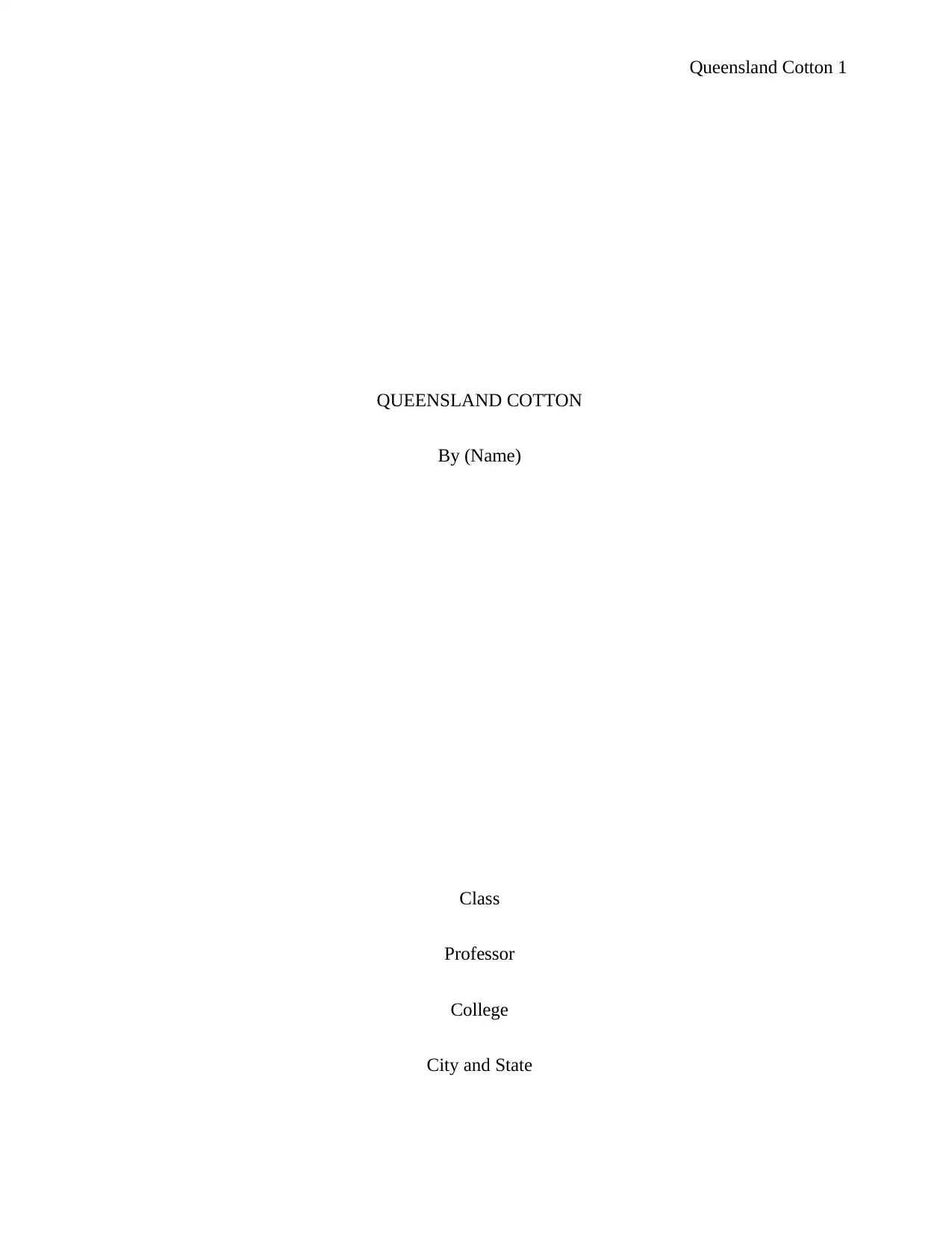
Queensland Cotton 1
QUEENSLAND COTTON
By (Name)
Class
Professor
College
City and State
QUEENSLAND COTTON
By (Name)
Class
Professor
College
City and State
Paraphrase This Document
Need a fresh take? Get an instant paraphrase of this document with our AI Paraphraser
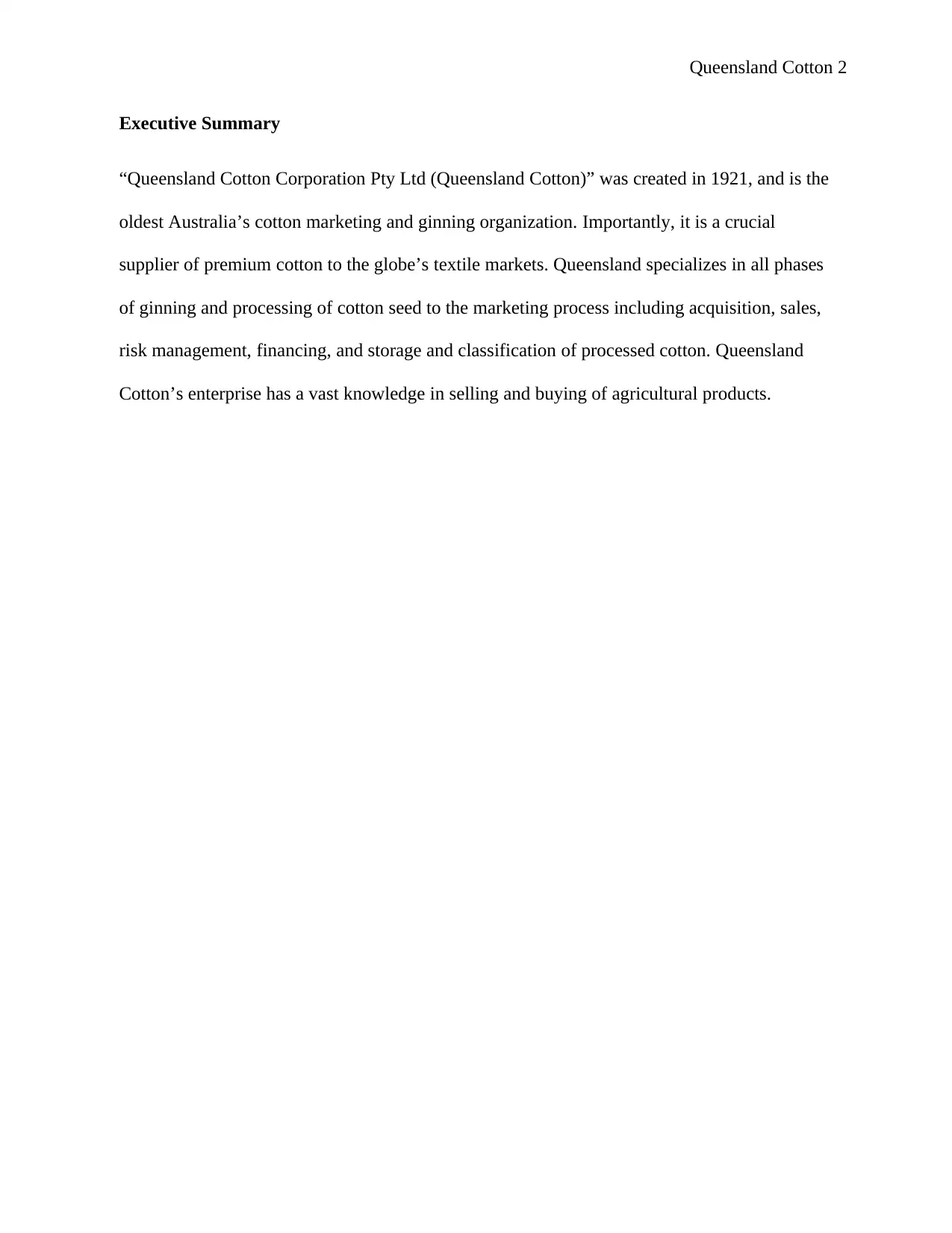
Queensland Cotton 2
Executive Summary
“Queensland Cotton Corporation Pty Ltd (Queensland Cotton)” was created in 1921, and is the
oldest Australia’s cotton marketing and ginning organization. Importantly, it is a crucial
supplier of premium cotton to the globe’s textile markets. Queensland specializes in all phases
of ginning and processing of cotton seed to the marketing process including acquisition, sales,
risk management, financing, and storage and classification of processed cotton. Queensland
Cotton’s enterprise has a vast knowledge in selling and buying of agricultural products.
Executive Summary
“Queensland Cotton Corporation Pty Ltd (Queensland Cotton)” was created in 1921, and is the
oldest Australia’s cotton marketing and ginning organization. Importantly, it is a crucial
supplier of premium cotton to the globe’s textile markets. Queensland specializes in all phases
of ginning and processing of cotton seed to the marketing process including acquisition, sales,
risk management, financing, and storage and classification of processed cotton. Queensland
Cotton’s enterprise has a vast knowledge in selling and buying of agricultural products.
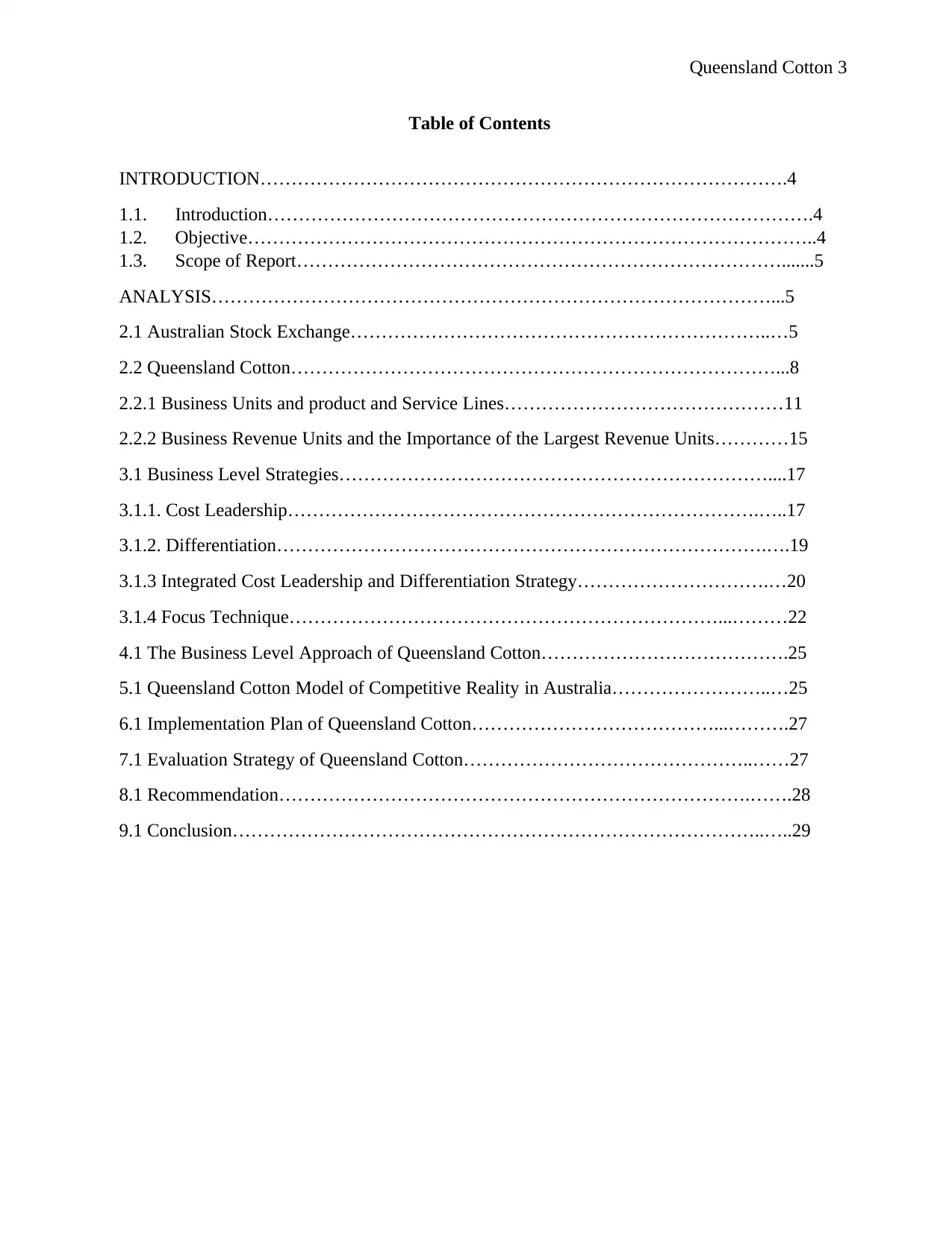
Queensland Cotton 3
Table of Contents
INTRODUCTION………………………………………………………………………….4
1.1. Introduction…………………………………………………………………………….4
1.2. Objective………………………………………………………………………………..4
1.3. Scope of Report…………………………………………………………………….......5
ANALYSIS………………………………………………………………………………...5
2.1 Australian Stock Exchange…………………………………………………………..…5
2.2 Queensland Cotton……………………………………………………………………...8
2.2.1 Business Units and product and Service Lines………………………………………11
2.2.2 Business Revenue Units and the Importance of the Largest Revenue Units…………15
3.1 Business Level Strategies……………………………………………………………....17
3.1.1. Cost Leadership………………………………………………………………….…..17
3.1.2. Differentiation…………………………………………………………………….….19
3.1.3 Integrated Cost Leadership and Differentiation Strategy………………………….…20
3.1.4 Focus Technique……………………………………………………………...………22
4.1 The Business Level Approach of Queensland Cotton………………………………….25
5.1 Queensland Cotton Model of Competitive Reality in Australia……………………..…25
6.1 Implementation Plan of Queensland Cotton…………………………………...……….27
7.1 Evaluation Strategy of Queensland Cotton………………………………………..……27
8.1 Recommendation………………………………………………………………….…….28
9.1 Conclusion…………………………………………………………………………..…..29
Table of Contents
INTRODUCTION………………………………………………………………………….4
1.1. Introduction…………………………………………………………………………….4
1.2. Objective………………………………………………………………………………..4
1.3. Scope of Report…………………………………………………………………….......5
ANALYSIS………………………………………………………………………………...5
2.1 Australian Stock Exchange…………………………………………………………..…5
2.2 Queensland Cotton……………………………………………………………………...8
2.2.1 Business Units and product and Service Lines………………………………………11
2.2.2 Business Revenue Units and the Importance of the Largest Revenue Units…………15
3.1 Business Level Strategies……………………………………………………………....17
3.1.1. Cost Leadership………………………………………………………………….…..17
3.1.2. Differentiation…………………………………………………………………….….19
3.1.3 Integrated Cost Leadership and Differentiation Strategy………………………….…20
3.1.4 Focus Technique……………………………………………………………...………22
4.1 The Business Level Approach of Queensland Cotton………………………………….25
5.1 Queensland Cotton Model of Competitive Reality in Australia……………………..…25
6.1 Implementation Plan of Queensland Cotton…………………………………...……….27
7.1 Evaluation Strategy of Queensland Cotton………………………………………..……27
8.1 Recommendation………………………………………………………………….…….28
9.1 Conclusion…………………………………………………………………………..…..29
You're viewing a preview
Unlock full access by subscribing today!

Queensland Cotton 4
INTRODUCTION
1.1 Introduction
The primary production regions of cotton in Australia stretches from the Macintyre
River on the Queensland border and Macquarie and Namoi valleys. In Queensland, the cotton
grown majorly is in the south in the Macintyre, Darling Downs, and Dirranbandi Valley areas.
The Australian cotton grows seasonally for about six months starting from October, which is the
planting season to ending April, which is the picking season. Notably, irrigation water for
cotton production is limited, which is a primary issue. In addition, water utilization efficiency
has increased by about 240 percent from the 1970s. Alternatively, the best management
programs of cotton practice include “Integrated Pest Management” strategies, and
biotechnology use in minimizing pesticide use by over 85 percent from 2000 to 2010.
Furthermore, cotton production forecasts at approximately 4.8 million bales, while the harvested
region is predicted at 450,000 hectares from 2018 to 2019. The low production is as a result of
low rainfall in most growing areas, and cotton crop damage influenced by herbicide spray drift
over about 36,000 hectares. Conversely, the “Cotton Research and Development Corporation
(CRDC)” delivers outcomes in cotton “Research, Development, and Extension (RD&E)” on
behalf of all Australian cotton growers, and the Australian government. Importantly, CRDC
plays a vital role in the 2018 to 2023 Strategic Plan that aims at building a successful five-year
plan on providing a two billion dollars gross value of cotton production, which will benefit
Australian cotton growers.
1.2 Objective
INTRODUCTION
1.1 Introduction
The primary production regions of cotton in Australia stretches from the Macintyre
River on the Queensland border and Macquarie and Namoi valleys. In Queensland, the cotton
grown majorly is in the south in the Macintyre, Darling Downs, and Dirranbandi Valley areas.
The Australian cotton grows seasonally for about six months starting from October, which is the
planting season to ending April, which is the picking season. Notably, irrigation water for
cotton production is limited, which is a primary issue. In addition, water utilization efficiency
has increased by about 240 percent from the 1970s. Alternatively, the best management
programs of cotton practice include “Integrated Pest Management” strategies, and
biotechnology use in minimizing pesticide use by over 85 percent from 2000 to 2010.
Furthermore, cotton production forecasts at approximately 4.8 million bales, while the harvested
region is predicted at 450,000 hectares from 2018 to 2019. The low production is as a result of
low rainfall in most growing areas, and cotton crop damage influenced by herbicide spray drift
over about 36,000 hectares. Conversely, the “Cotton Research and Development Corporation
(CRDC)” delivers outcomes in cotton “Research, Development, and Extension (RD&E)” on
behalf of all Australian cotton growers, and the Australian government. Importantly, CRDC
plays a vital role in the 2018 to 2023 Strategic Plan that aims at building a successful five-year
plan on providing a two billion dollars gross value of cotton production, which will benefit
Australian cotton growers.
1.2 Objective
Paraphrase This Document
Need a fresh take? Get an instant paraphrase of this document with our AI Paraphraser

Queensland Cotton 5
The report aims at providing an in-depth analysis of Queensland Cotton, and the business units
and product lines. Also, the report focuses on Queensland Cotton prioritizes on business
strategy, which keeps it ahead of its competition. In spite of that, the article addresses the
following;
1. Queensland Cotton business level approach.
2. Queensland Cotton model of competitive reality.
3. The implementation plan and assessment strategy of Queensland Cotton.
1.3 Scope of Report
The article focuses on Queensland Cotton and how it achieves the cost leadership and
differentiation approach. Also, the business revenue units of Queensland Cotton are provided.
ANALYSIS
2.1 Australian Stock Exchange
“Australia Bureau of Agricultural and Resource Economics (ABARE)” June 2012
estimated that the Australian cotton exports may increase by at least 11.5 percent in 2012 and
2013, which is about 1.2 million tonnes. The forecast in 2012 predicted a 26 percent decrease in
cotton planted areas at 442,000 hectares, while irrigated cotton regions decreased by seven
percent to 418,000 hectares, and the regions of dryland cotton fell by 85 percent to 23,000
hectares. Importantly, Australia is a net cotton exporter, and the prices reflect in USD terms.
The USD is a currency of international cotton trade, which Australian cotton exports denote it
by the US dollar. NSW and Queensland growers predominantly operate an Australian dollar-
denominated enterprise, and prefer to have their sales receipts in “AUD.”
The report aims at providing an in-depth analysis of Queensland Cotton, and the business units
and product lines. Also, the report focuses on Queensland Cotton prioritizes on business
strategy, which keeps it ahead of its competition. In spite of that, the article addresses the
following;
1. Queensland Cotton business level approach.
2. Queensland Cotton model of competitive reality.
3. The implementation plan and assessment strategy of Queensland Cotton.
1.3 Scope of Report
The article focuses on Queensland Cotton and how it achieves the cost leadership and
differentiation approach. Also, the business revenue units of Queensland Cotton are provided.
ANALYSIS
2.1 Australian Stock Exchange
“Australia Bureau of Agricultural and Resource Economics (ABARE)” June 2012
estimated that the Australian cotton exports may increase by at least 11.5 percent in 2012 and
2013, which is about 1.2 million tonnes. The forecast in 2012 predicted a 26 percent decrease in
cotton planted areas at 442,000 hectares, while irrigated cotton regions decreased by seven
percent to 418,000 hectares, and the regions of dryland cotton fell by 85 percent to 23,000
hectares. Importantly, Australia is a net cotton exporter, and the prices reflect in USD terms.
The USD is a currency of international cotton trade, which Australian cotton exports denote it
by the US dollar. NSW and Queensland growers predominantly operate an Australian dollar-
denominated enterprise, and prefer to have their sales receipts in “AUD.”
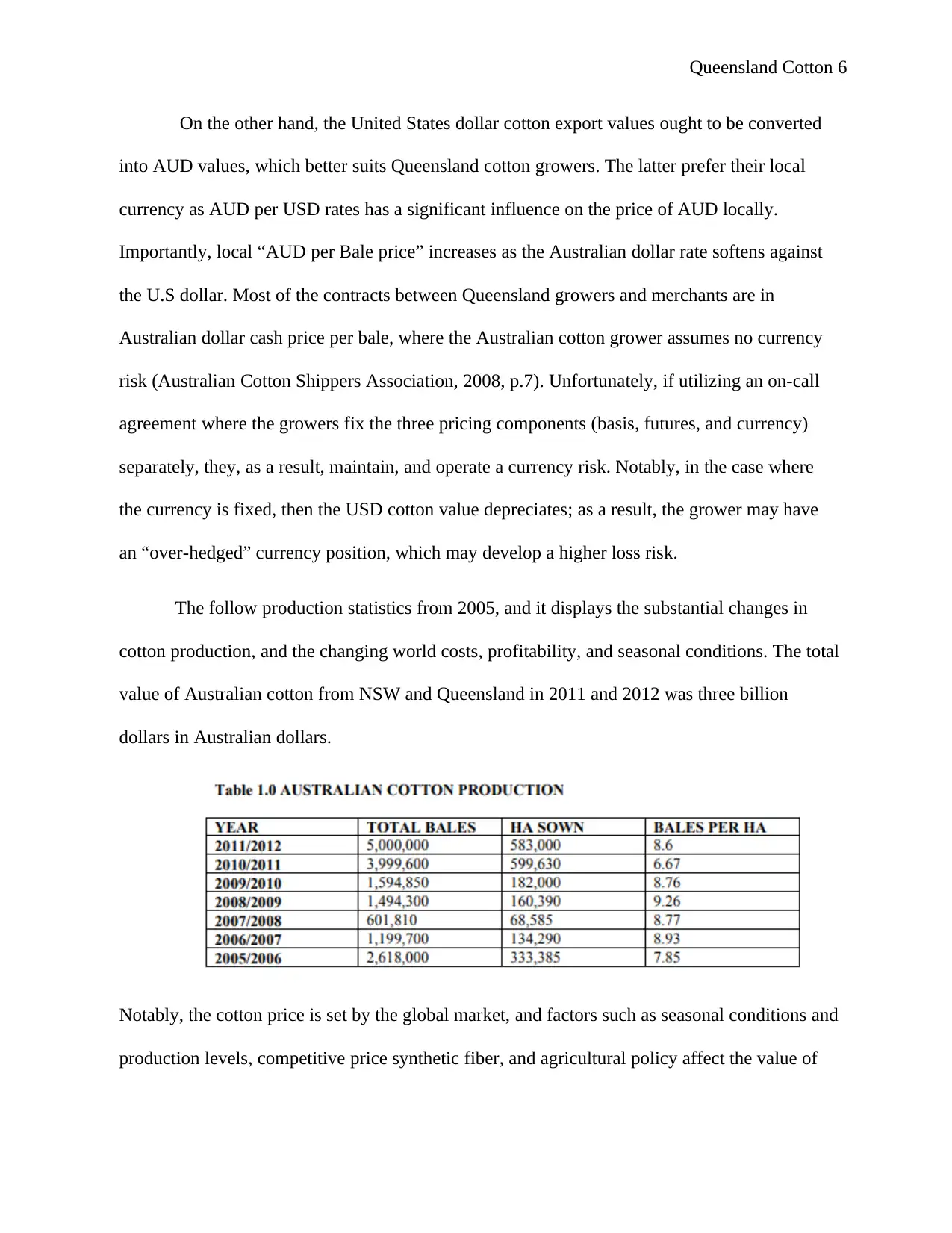
Queensland Cotton 6
On the other hand, the United States dollar cotton export values ought to be converted
into AUD values, which better suits Queensland cotton growers. The latter prefer their local
currency as AUD per USD rates has a significant influence on the price of AUD locally.
Importantly, local “AUD per Bale price” increases as the Australian dollar rate softens against
the U.S dollar. Most of the contracts between Queensland growers and merchants are in
Australian dollar cash price per bale, where the Australian cotton grower assumes no currency
risk (Australian Cotton Shippers Association, 2008, p.7). Unfortunately, if utilizing an on-call
agreement where the growers fix the three pricing components (basis, futures, and currency)
separately, they, as a result, maintain, and operate a currency risk. Notably, in the case where
the currency is fixed, then the USD cotton value depreciates; as a result, the grower may have
an “over-hedged” currency position, which may develop a higher loss risk.
The follow production statistics from 2005, and it displays the substantial changes in
cotton production, and the changing world costs, profitability, and seasonal conditions. The total
value of Australian cotton from NSW and Queensland in 2011 and 2012 was three billion
dollars in Australian dollars.
Notably, the cotton price is set by the global market, and factors such as seasonal conditions and
production levels, competitive price synthetic fiber, and agricultural policy affect the value of
On the other hand, the United States dollar cotton export values ought to be converted
into AUD values, which better suits Queensland cotton growers. The latter prefer their local
currency as AUD per USD rates has a significant influence on the price of AUD locally.
Importantly, local “AUD per Bale price” increases as the Australian dollar rate softens against
the U.S dollar. Most of the contracts between Queensland growers and merchants are in
Australian dollar cash price per bale, where the Australian cotton grower assumes no currency
risk (Australian Cotton Shippers Association, 2008, p.7). Unfortunately, if utilizing an on-call
agreement where the growers fix the three pricing components (basis, futures, and currency)
separately, they, as a result, maintain, and operate a currency risk. Notably, in the case where
the currency is fixed, then the USD cotton value depreciates; as a result, the grower may have
an “over-hedged” currency position, which may develop a higher loss risk.
The follow production statistics from 2005, and it displays the substantial changes in
cotton production, and the changing world costs, profitability, and seasonal conditions. The total
value of Australian cotton from NSW and Queensland in 2011 and 2012 was three billion
dollars in Australian dollars.
Notably, the cotton price is set by the global market, and factors such as seasonal conditions and
production levels, competitive price synthetic fiber, and agricultural policy affect the value of
You're viewing a preview
Unlock full access by subscribing today!

Queensland Cotton 7
cotton (De Garis, 2013, p.7). Recently, the cost is about 1,000 Australian dollar per bale, and a
region of 350 dollars to 4000 dollars per Australian bale dollar.
Importantly, Australia is the fourth largest cotton exporter worldwide, where the largest
export market is in Indonesia at 30 percent, followed by Japan at 20 percent. From figure 1, the
June 2018 stock exchange market indicate that 104,988 is the total listing for the whole stock
exchange, which is a two percent decrease from the sales stock in 2017 (Salas, 2018, p.72).
Figure 1: The Market Indicators
The Australian cotton export has drastically reduced over the recent years to widespread
drought, which has caused the drop of Australia from the top five world cotton exporters.
Importantly, Australia (NSW and Queensland) is predicted to export 2.5 million bales in 2018
cotton (De Garis, 2013, p.7). Recently, the cost is about 1,000 Australian dollar per bale, and a
region of 350 dollars to 4000 dollars per Australian bale dollar.
Importantly, Australia is the fourth largest cotton exporter worldwide, where the largest
export market is in Indonesia at 30 percent, followed by Japan at 20 percent. From figure 1, the
June 2018 stock exchange market indicate that 104,988 is the total listing for the whole stock
exchange, which is a two percent decrease from the sales stock in 2017 (Salas, 2018, p.72).
Figure 1: The Market Indicators
The Australian cotton export has drastically reduced over the recent years to widespread
drought, which has caused the drop of Australia from the top five world cotton exporters.
Importantly, Australia (NSW and Queensland) is predicted to export 2.5 million bales in 2018
Paraphrase This Document
Need a fresh take? Get an instant paraphrase of this document with our AI Paraphraser
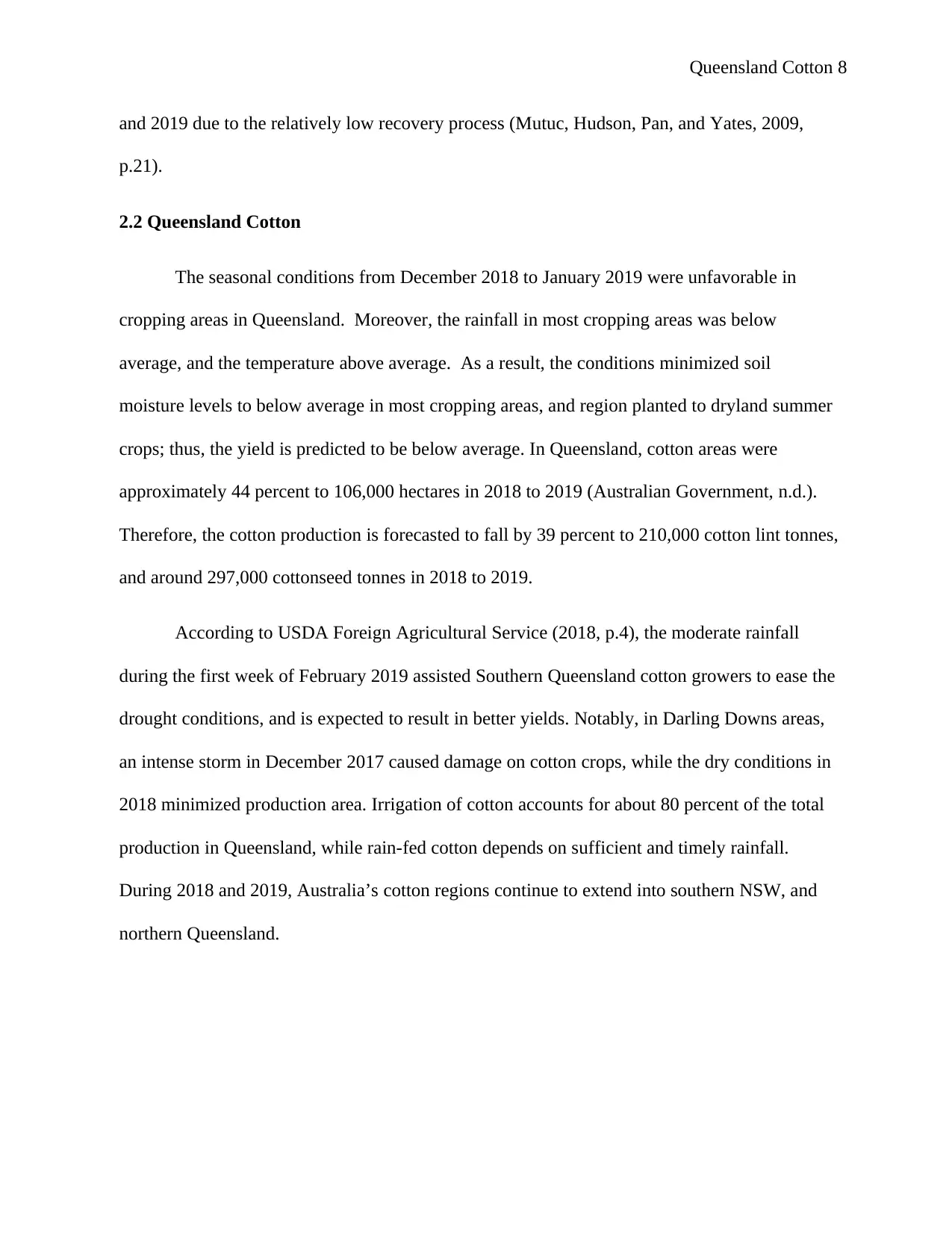
Queensland Cotton 8
and 2019 due to the relatively low recovery process (Mutuc, Hudson, Pan, and Yates, 2009,
p.21).
2.2 Queensland Cotton
The seasonal conditions from December 2018 to January 2019 were unfavorable in
cropping areas in Queensland. Moreover, the rainfall in most cropping areas was below
average, and the temperature above average. As a result, the conditions minimized soil
moisture levels to below average in most cropping areas, and region planted to dryland summer
crops; thus, the yield is predicted to be below average. In Queensland, cotton areas were
approximately 44 percent to 106,000 hectares in 2018 to 2019 (Australian Government, n.d.).
Therefore, the cotton production is forecasted to fall by 39 percent to 210,000 cotton lint tonnes,
and around 297,000 cottonseed tonnes in 2018 to 2019.
According to USDA Foreign Agricultural Service (2018, p.4), the moderate rainfall
during the first week of February 2019 assisted Southern Queensland cotton growers to ease the
drought conditions, and is expected to result in better yields. Notably, in Darling Downs areas,
an intense storm in December 2017 caused damage on cotton crops, while the dry conditions in
2018 minimized production area. Irrigation of cotton accounts for about 80 percent of the total
production in Queensland, while rain-fed cotton depends on sufficient and timely rainfall.
During 2018 and 2019, Australia’s cotton regions continue to extend into southern NSW, and
northern Queensland.
and 2019 due to the relatively low recovery process (Mutuc, Hudson, Pan, and Yates, 2009,
p.21).
2.2 Queensland Cotton
The seasonal conditions from December 2018 to January 2019 were unfavorable in
cropping areas in Queensland. Moreover, the rainfall in most cropping areas was below
average, and the temperature above average. As a result, the conditions minimized soil
moisture levels to below average in most cropping areas, and region planted to dryland summer
crops; thus, the yield is predicted to be below average. In Queensland, cotton areas were
approximately 44 percent to 106,000 hectares in 2018 to 2019 (Australian Government, n.d.).
Therefore, the cotton production is forecasted to fall by 39 percent to 210,000 cotton lint tonnes,
and around 297,000 cottonseed tonnes in 2018 to 2019.
According to USDA Foreign Agricultural Service (2018, p.4), the moderate rainfall
during the first week of February 2019 assisted Southern Queensland cotton growers to ease the
drought conditions, and is expected to result in better yields. Notably, in Darling Downs areas,
an intense storm in December 2017 caused damage on cotton crops, while the dry conditions in
2018 minimized production area. Irrigation of cotton accounts for about 80 percent of the total
production in Queensland, while rain-fed cotton depends on sufficient and timely rainfall.
During 2018 and 2019, Australia’s cotton regions continue to extend into southern NSW, and
northern Queensland.
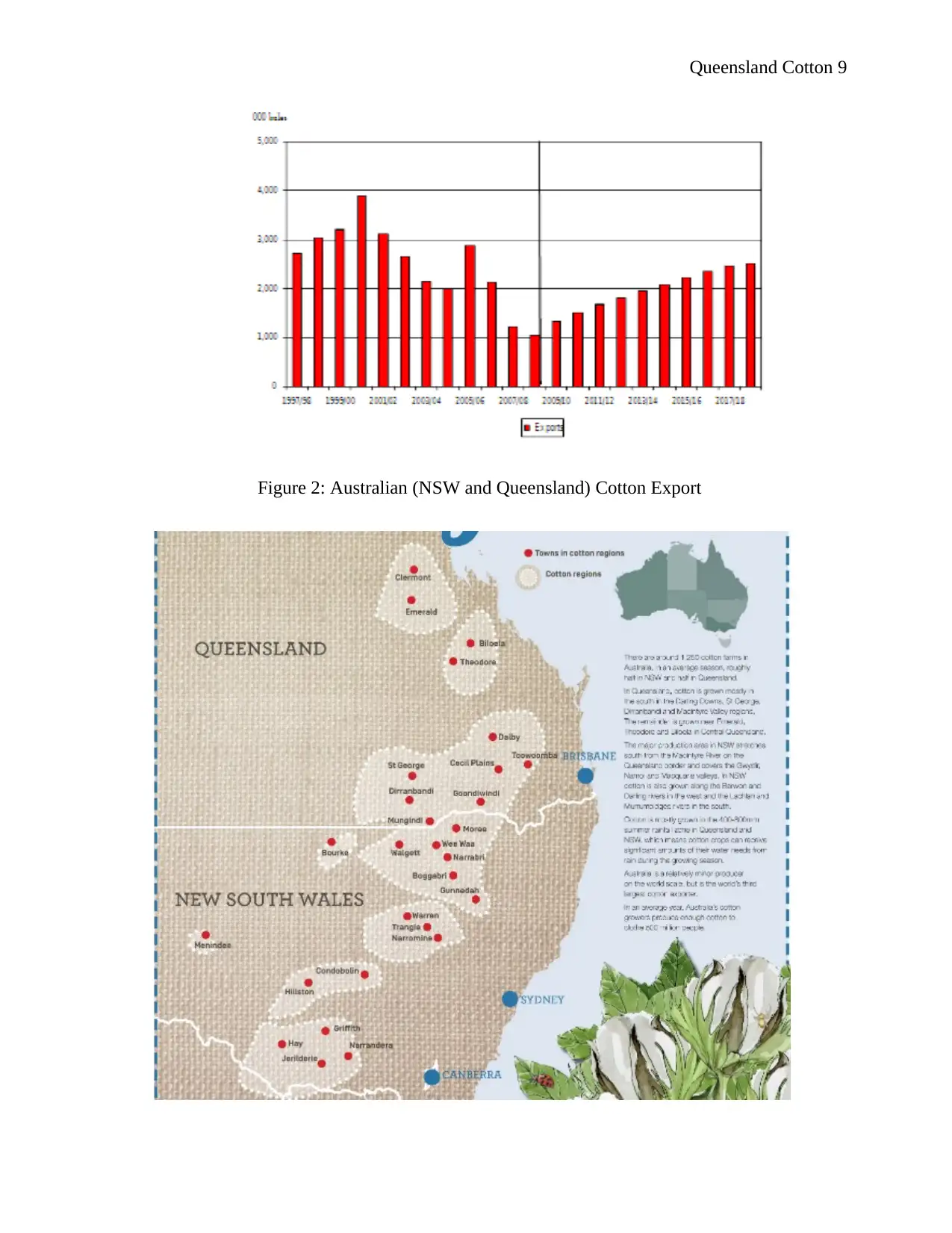
Queensland Cotton 9
Figure 2: Australian (NSW and Queensland) Cotton Export
Figure 2: Australian (NSW and Queensland) Cotton Export
You're viewing a preview
Unlock full access by subscribing today!
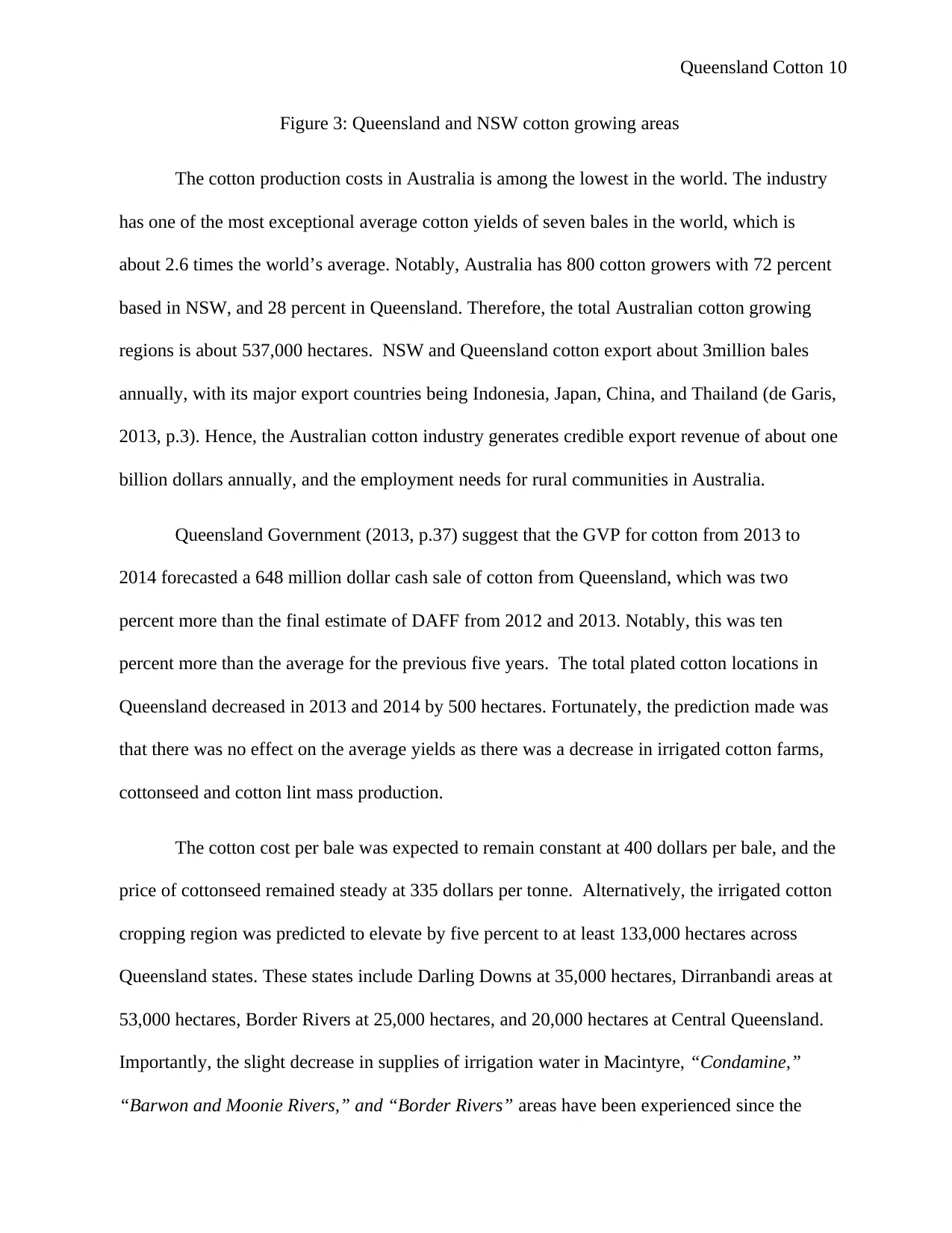
Queensland Cotton 10
Figure 3: Queensland and NSW cotton growing areas
The cotton production costs in Australia is among the lowest in the world. The industry
has one of the most exceptional average cotton yields of seven bales in the world, which is
about 2.6 times the world’s average. Notably, Australia has 800 cotton growers with 72 percent
based in NSW, and 28 percent in Queensland. Therefore, the total Australian cotton growing
regions is about 537,000 hectares. NSW and Queensland cotton export about 3million bales
annually, with its major export countries being Indonesia, Japan, China, and Thailand (de Garis,
2013, p.3). Hence, the Australian cotton industry generates credible export revenue of about one
billion dollars annually, and the employment needs for rural communities in Australia.
Queensland Government (2013, p.37) suggest that the GVP for cotton from 2013 to
2014 forecasted a 648 million dollar cash sale of cotton from Queensland, which was two
percent more than the final estimate of DAFF from 2012 and 2013. Notably, this was ten
percent more than the average for the previous five years. The total plated cotton locations in
Queensland decreased in 2013 and 2014 by 500 hectares. Fortunately, the prediction made was
that there was no effect on the average yields as there was a decrease in irrigated cotton farms,
cottonseed and cotton lint mass production.
The cotton cost per bale was expected to remain constant at 400 dollars per bale, and the
price of cottonseed remained steady at 335 dollars per tonne. Alternatively, the irrigated cotton
cropping region was predicted to elevate by five percent to at least 133,000 hectares across
Queensland states. These states include Darling Downs at 35,000 hectares, Dirranbandi areas at
53,000 hectares, Border Rivers at 25,000 hectares, and 20,000 hectares at Central Queensland.
Importantly, the slight decrease in supplies of irrigation water in Macintyre, “Condamine,”
“Barwon and Moonie Rivers,” and “Border Rivers” areas have been experienced since the
Figure 3: Queensland and NSW cotton growing areas
The cotton production costs in Australia is among the lowest in the world. The industry
has one of the most exceptional average cotton yields of seven bales in the world, which is
about 2.6 times the world’s average. Notably, Australia has 800 cotton growers with 72 percent
based in NSW, and 28 percent in Queensland. Therefore, the total Australian cotton growing
regions is about 537,000 hectares. NSW and Queensland cotton export about 3million bales
annually, with its major export countries being Indonesia, Japan, China, and Thailand (de Garis,
2013, p.3). Hence, the Australian cotton industry generates credible export revenue of about one
billion dollars annually, and the employment needs for rural communities in Australia.
Queensland Government (2013, p.37) suggest that the GVP for cotton from 2013 to
2014 forecasted a 648 million dollar cash sale of cotton from Queensland, which was two
percent more than the final estimate of DAFF from 2012 and 2013. Notably, this was ten
percent more than the average for the previous five years. The total plated cotton locations in
Queensland decreased in 2013 and 2014 by 500 hectares. Fortunately, the prediction made was
that there was no effect on the average yields as there was a decrease in irrigated cotton farms,
cottonseed and cotton lint mass production.
The cotton cost per bale was expected to remain constant at 400 dollars per bale, and the
price of cottonseed remained steady at 335 dollars per tonne. Alternatively, the irrigated cotton
cropping region was predicted to elevate by five percent to at least 133,000 hectares across
Queensland states. These states include Darling Downs at 35,000 hectares, Dirranbandi areas at
53,000 hectares, Border Rivers at 25,000 hectares, and 20,000 hectares at Central Queensland.
Importantly, the slight decrease in supplies of irrigation water in Macintyre, “Condamine,”
“Barwon and Moonie Rivers,” and “Border Rivers” areas have been experienced since the
Paraphrase This Document
Need a fresh take? Get an instant paraphrase of this document with our AI Paraphraser
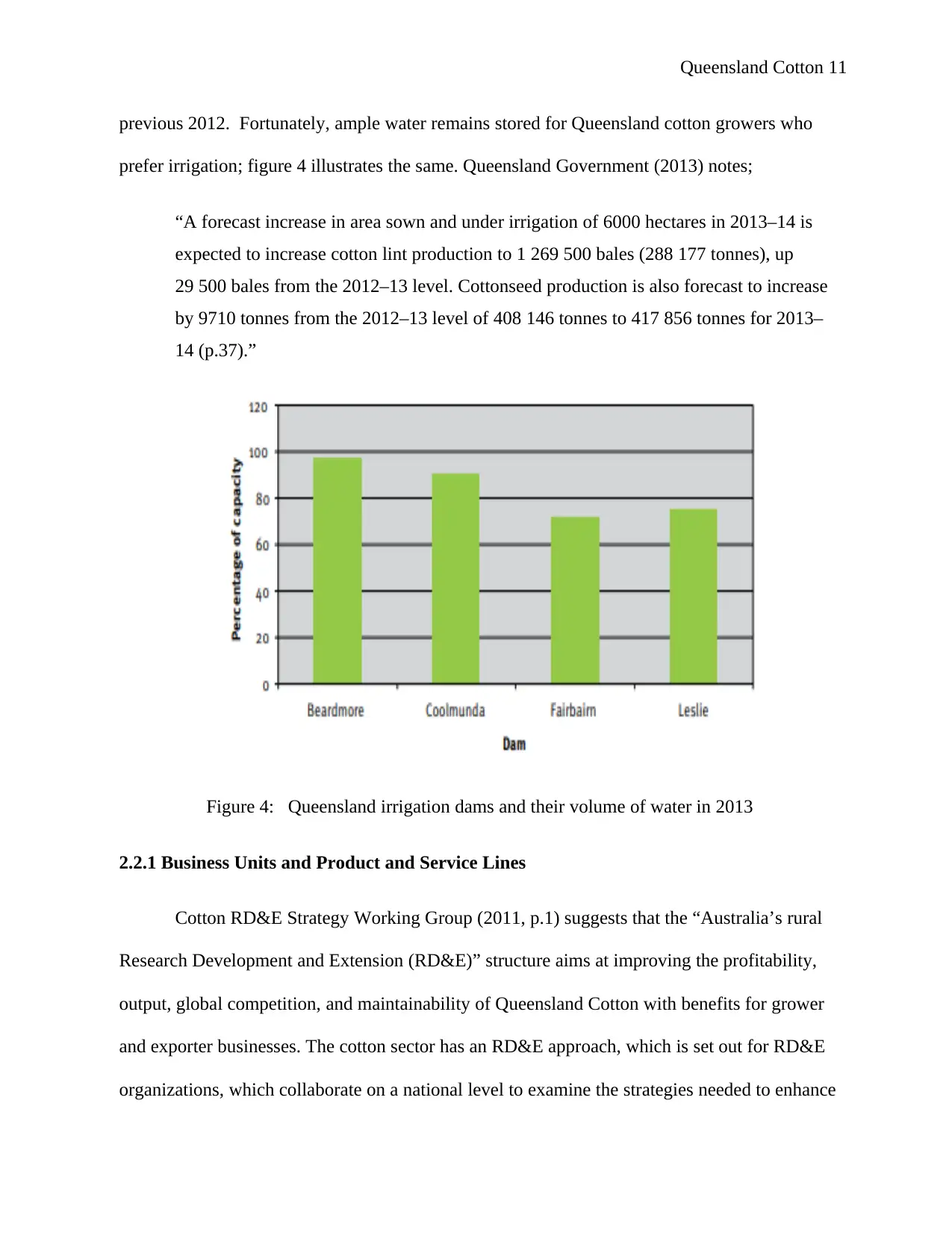
Queensland Cotton 11
previous 2012. Fortunately, ample water remains stored for Queensland cotton growers who
prefer irrigation; figure 4 illustrates the same. Queensland Government (2013) notes;
“A forecast increase in area sown and under irrigation of 6000 hectares in 2013–14 is
expected to increase cotton lint production to 1 269 500 bales (288 177 tonnes), up
29 500 bales from the 2012–13 level. Cottonseed production is also forecast to increase
by 9710 tonnes from the 2012–13 level of 408 146 tonnes to 417 856 tonnes for 2013–
14 (p.37).”
Figure 4: Queensland irrigation dams and their volume of water in 2013
2.2.1 Business Units and Product and Service Lines
Cotton RD&E Strategy Working Group (2011, p.1) suggests that the “Australia’s rural
Research Development and Extension (RD&E)” structure aims at improving the profitability,
output, global competition, and maintainability of Queensland Cotton with benefits for grower
and exporter businesses. The cotton sector has an RD&E approach, which is set out for RD&E
organizations, which collaborate on a national level to examine the strategies needed to enhance
previous 2012. Fortunately, ample water remains stored for Queensland cotton growers who
prefer irrigation; figure 4 illustrates the same. Queensland Government (2013) notes;
“A forecast increase in area sown and under irrigation of 6000 hectares in 2013–14 is
expected to increase cotton lint production to 1 269 500 bales (288 177 tonnes), up
29 500 bales from the 2012–13 level. Cottonseed production is also forecast to increase
by 9710 tonnes from the 2012–13 level of 408 146 tonnes to 417 856 tonnes for 2013–
14 (p.37).”
Figure 4: Queensland irrigation dams and their volume of water in 2013
2.2.1 Business Units and Product and Service Lines
Cotton RD&E Strategy Working Group (2011, p.1) suggests that the “Australia’s rural
Research Development and Extension (RD&E)” structure aims at improving the profitability,
output, global competition, and maintainability of Queensland Cotton with benefits for grower
and exporter businesses. The cotton sector has an RD&E approach, which is set out for RD&E
organizations, which collaborate on a national level to examine the strategies needed to enhance

Queensland Cotton 12
the sector. These approaches may include establishing a process of allocating resources across
priority regions of cotton growing such as Queensland and NSW, and the ongoing maintenance
of national capacity and effort. Alternatively, RD&E structure establishes a process for the
operation of innovation, which will maximize profits in Queensland Cotton.
The Queensland Cotton utilizes the RD&E strategy to develop through a Working
Group involving “Cotton Research and Development Corporation (CRDC),” “Cotton
Catchment Communities Cooperative Research Centre (Cotton CRC),” and “Cotton Seed
Distributors (CSD).” The Queensland and NSW cotton produces a mean of 499kt cotton lint,
and 688kt of cottonseed annually from 308,000 hectares, although in recent years the sector has
faced challenges due to climate change, which has resulted to long drought periods.
Importantly, the production degree varies depending on water availability, and the extent of the
market of conditions (Cotton Australia, 2008, p.5). Most of the Australian cotton industry relies
on the central and northern NSW, and central and southern Queensland, which give an
economic cornerstone for numerous zonal communities that employ at 13,000 workers.
The environmental sustainability and productivity of the cotton manufacturing have
enhanced enormously over the past 20 years through technology creation, and superior manage
operations. These enhancements underline the swift development of the cotton manufacturing
since the 1990s, and helped in maintaining global competition, and adaptability to famine since
2000s. Queensland Government’s method to attain sustainable economic development focuses
on several policy channels, which are managed by the state’s priorities of innovation,
investment, and infrastructure (Queensland Australia, 2017, p.13). Notably, the main product
line in Queensland Cotton is cotton, and the technique connects to promoting cotton enterprise
exports and investment.
the sector. These approaches may include establishing a process of allocating resources across
priority regions of cotton growing such as Queensland and NSW, and the ongoing maintenance
of national capacity and effort. Alternatively, RD&E structure establishes a process for the
operation of innovation, which will maximize profits in Queensland Cotton.
The Queensland Cotton utilizes the RD&E strategy to develop through a Working
Group involving “Cotton Research and Development Corporation (CRDC),” “Cotton
Catchment Communities Cooperative Research Centre (Cotton CRC),” and “Cotton Seed
Distributors (CSD).” The Queensland and NSW cotton produces a mean of 499kt cotton lint,
and 688kt of cottonseed annually from 308,000 hectares, although in recent years the sector has
faced challenges due to climate change, which has resulted to long drought periods.
Importantly, the production degree varies depending on water availability, and the extent of the
market of conditions (Cotton Australia, 2008, p.5). Most of the Australian cotton industry relies
on the central and northern NSW, and central and southern Queensland, which give an
economic cornerstone for numerous zonal communities that employ at 13,000 workers.
The environmental sustainability and productivity of the cotton manufacturing have
enhanced enormously over the past 20 years through technology creation, and superior manage
operations. These enhancements underline the swift development of the cotton manufacturing
since the 1990s, and helped in maintaining global competition, and adaptability to famine since
2000s. Queensland Government’s method to attain sustainable economic development focuses
on several policy channels, which are managed by the state’s priorities of innovation,
investment, and infrastructure (Queensland Australia, 2017, p.13). Notably, the main product
line in Queensland Cotton is cotton, and the technique connects to promoting cotton enterprise
exports and investment.
You're viewing a preview
Unlock full access by subscribing today!
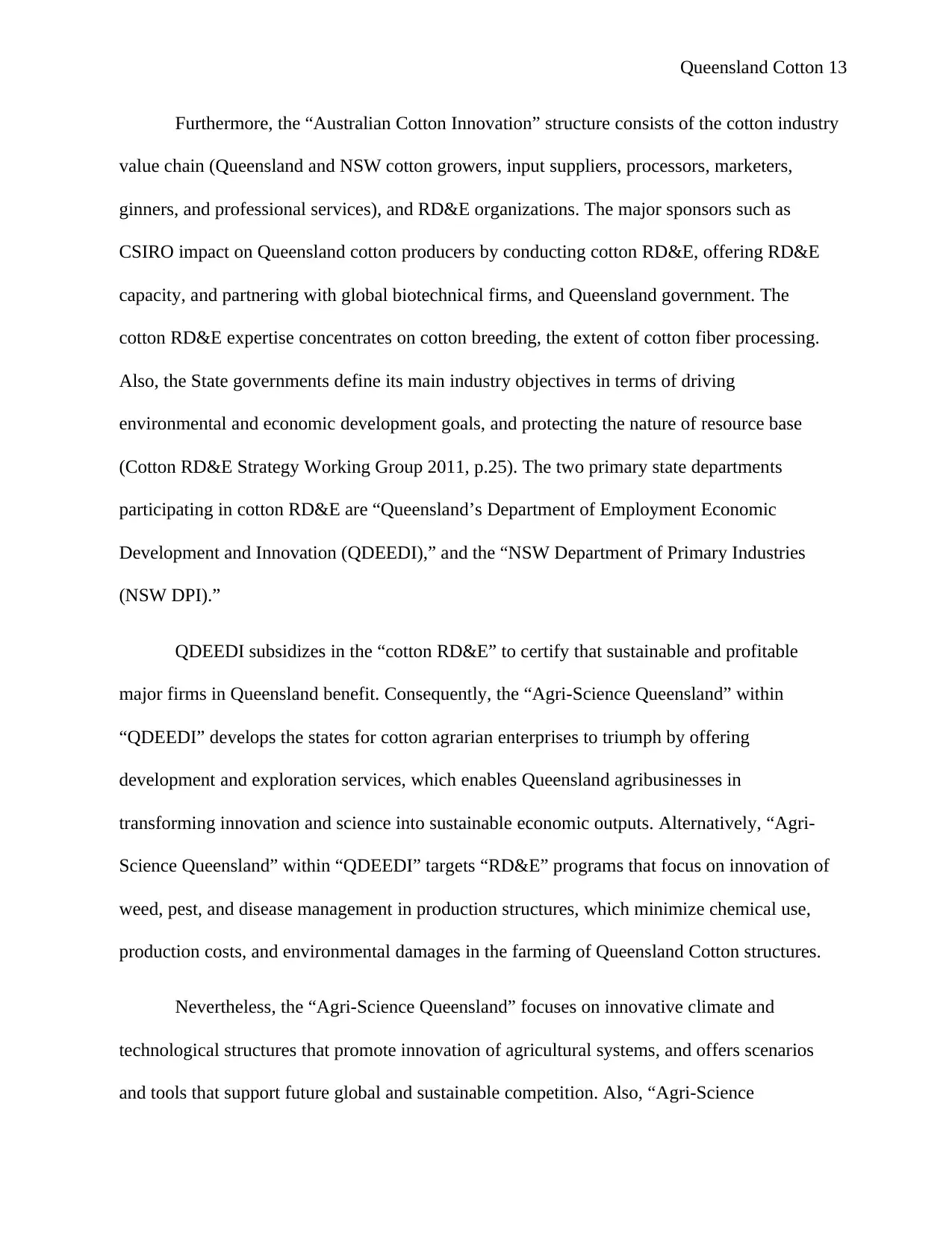
Queensland Cotton 13
Furthermore, the “Australian Cotton Innovation” structure consists of the cotton industry
value chain (Queensland and NSW cotton growers, input suppliers, processors, marketers,
ginners, and professional services), and RD&E organizations. The major sponsors such as
CSIRO impact on Queensland cotton producers by conducting cotton RD&E, offering RD&E
capacity, and partnering with global biotechnical firms, and Queensland government. The
cotton RD&E expertise concentrates on cotton breeding, the extent of cotton fiber processing.
Also, the State governments define its main industry objectives in terms of driving
environmental and economic development goals, and protecting the nature of resource base
(Cotton RD&E Strategy Working Group 2011, p.25). The two primary state departments
participating in cotton RD&E are “Queensland’s Department of Employment Economic
Development and Innovation (QDEEDI),” and the “NSW Department of Primary Industries
(NSW DPI).”
QDEEDI subsidizes in the “cotton RD&E” to certify that sustainable and profitable
major firms in Queensland benefit. Consequently, the “Agri-Science Queensland” within
“QDEEDI” develops the states for cotton agrarian enterprises to triumph by offering
development and exploration services, which enables Queensland agribusinesses in
transforming innovation and science into sustainable economic outputs. Alternatively, “Agri-
Science Queensland” within “QDEEDI” targets “RD&E” programs that focus on innovation of
weed, pest, and disease management in production structures, which minimize chemical use,
production costs, and environmental damages in the farming of Queensland Cotton structures.
Nevertheless, the “Agri-Science Queensland” focuses on innovative climate and
technological structures that promote innovation of agricultural systems, and offers scenarios
and tools that support future global and sustainable competition. Also, “Agri-Science
Furthermore, the “Australian Cotton Innovation” structure consists of the cotton industry
value chain (Queensland and NSW cotton growers, input suppliers, processors, marketers,
ginners, and professional services), and RD&E organizations. The major sponsors such as
CSIRO impact on Queensland cotton producers by conducting cotton RD&E, offering RD&E
capacity, and partnering with global biotechnical firms, and Queensland government. The
cotton RD&E expertise concentrates on cotton breeding, the extent of cotton fiber processing.
Also, the State governments define its main industry objectives in terms of driving
environmental and economic development goals, and protecting the nature of resource base
(Cotton RD&E Strategy Working Group 2011, p.25). The two primary state departments
participating in cotton RD&E are “Queensland’s Department of Employment Economic
Development and Innovation (QDEEDI),” and the “NSW Department of Primary Industries
(NSW DPI).”
QDEEDI subsidizes in the “cotton RD&E” to certify that sustainable and profitable
major firms in Queensland benefit. Consequently, the “Agri-Science Queensland” within
“QDEEDI” develops the states for cotton agrarian enterprises to triumph by offering
development and exploration services, which enables Queensland agribusinesses in
transforming innovation and science into sustainable economic outputs. Alternatively, “Agri-
Science Queensland” within “QDEEDI” targets “RD&E” programs that focus on innovation of
weed, pest, and disease management in production structures, which minimize chemical use,
production costs, and environmental damages in the farming of Queensland Cotton structures.
Nevertheless, the “Agri-Science Queensland” focuses on innovative climate and
technological structures that promote innovation of agricultural systems, and offers scenarios
and tools that support future global and sustainable competition. Also, “Agri-Science
Paraphrase This Document
Need a fresh take? Get an instant paraphrase of this document with our AI Paraphraser
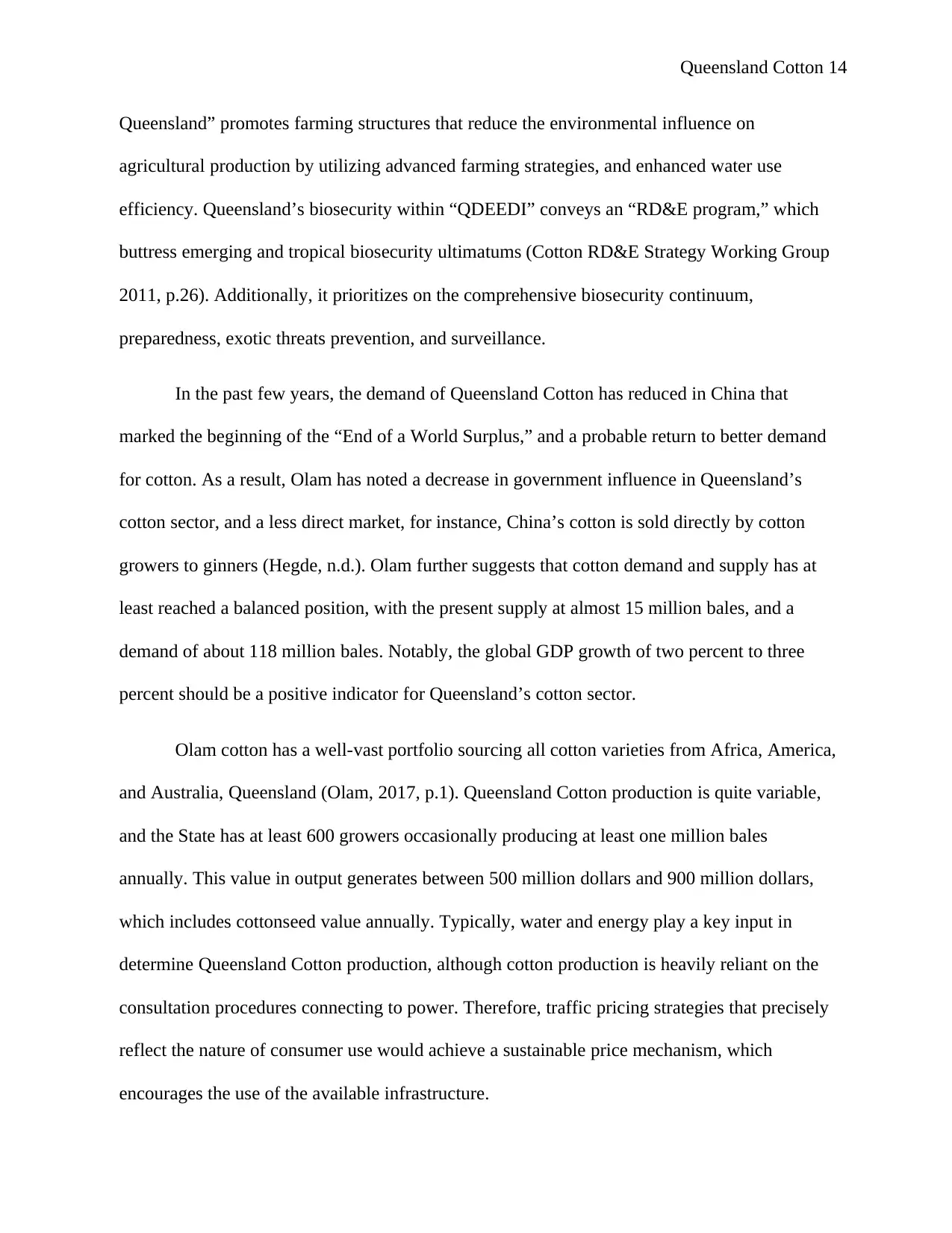
Queensland Cotton 14
Queensland” promotes farming structures that reduce the environmental influence on
agricultural production by utilizing advanced farming strategies, and enhanced water use
efficiency. Queensland’s biosecurity within “QDEEDI” conveys an “RD&E program,” which
buttress emerging and tropical biosecurity ultimatums (Cotton RD&E Strategy Working Group
2011, p.26). Additionally, it prioritizes on the comprehensive biosecurity continuum,
preparedness, exotic threats prevention, and surveillance.
In the past few years, the demand of Queensland Cotton has reduced in China that
marked the beginning of the “End of a World Surplus,” and a probable return to better demand
for cotton. As a result, Olam has noted a decrease in government influence in Queensland’s
cotton sector, and a less direct market, for instance, China’s cotton is sold directly by cotton
growers to ginners (Hegde, n.d.). Olam further suggests that cotton demand and supply has at
least reached a balanced position, with the present supply at almost 15 million bales, and a
demand of about 118 million bales. Notably, the global GDP growth of two percent to three
percent should be a positive indicator for Queensland’s cotton sector.
Olam cotton has a well-vast portfolio sourcing all cotton varieties from Africa, America,
and Australia, Queensland (Olam, 2017, p.1). Queensland Cotton production is quite variable,
and the State has at least 600 growers occasionally producing at least one million bales
annually. This value in output generates between 500 million dollars and 900 million dollars,
which includes cottonseed value annually. Typically, water and energy play a key input in
determine Queensland Cotton production, although cotton production is heavily reliant on the
consultation procedures connecting to power. Therefore, traffic pricing strategies that precisely
reflect the nature of consumer use would achieve a sustainable price mechanism, which
encourages the use of the available infrastructure.
Queensland” promotes farming structures that reduce the environmental influence on
agricultural production by utilizing advanced farming strategies, and enhanced water use
efficiency. Queensland’s biosecurity within “QDEEDI” conveys an “RD&E program,” which
buttress emerging and tropical biosecurity ultimatums (Cotton RD&E Strategy Working Group
2011, p.26). Additionally, it prioritizes on the comprehensive biosecurity continuum,
preparedness, exotic threats prevention, and surveillance.
In the past few years, the demand of Queensland Cotton has reduced in China that
marked the beginning of the “End of a World Surplus,” and a probable return to better demand
for cotton. As a result, Olam has noted a decrease in government influence in Queensland’s
cotton sector, and a less direct market, for instance, China’s cotton is sold directly by cotton
growers to ginners (Hegde, n.d.). Olam further suggests that cotton demand and supply has at
least reached a balanced position, with the present supply at almost 15 million bales, and a
demand of about 118 million bales. Notably, the global GDP growth of two percent to three
percent should be a positive indicator for Queensland’s cotton sector.
Olam cotton has a well-vast portfolio sourcing all cotton varieties from Africa, America,
and Australia, Queensland (Olam, 2017, p.1). Queensland Cotton production is quite variable,
and the State has at least 600 growers occasionally producing at least one million bales
annually. This value in output generates between 500 million dollars and 900 million dollars,
which includes cottonseed value annually. Typically, water and energy play a key input in
determine Queensland Cotton production, although cotton production is heavily reliant on the
consultation procedures connecting to power. Therefore, traffic pricing strategies that precisely
reflect the nature of consumer use would achieve a sustainable price mechanism, which
encourages the use of the available infrastructure.
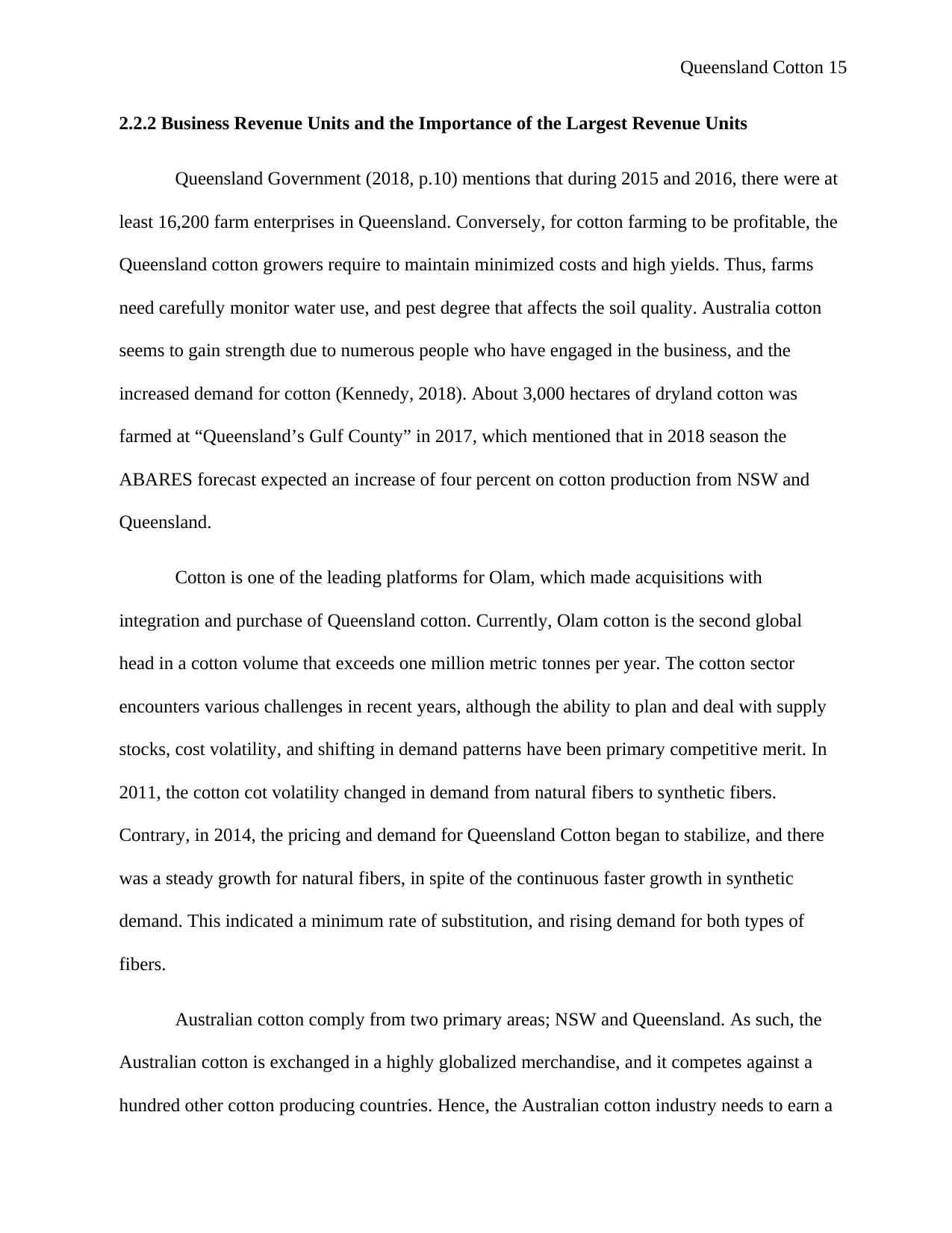
Queensland Cotton 15
2.2.2 Business Revenue Units and the Importance of the Largest Revenue Units
Queensland Government (2018, p.10) mentions that during 2015 and 2016, there were at
least 16,200 farm enterprises in Queensland. Conversely, for cotton farming to be profitable, the
Queensland cotton growers require to maintain minimized costs and high yields. Thus, farms
need carefully monitor water use, and pest degree that affects the soil quality. Australia cotton
seems to gain strength due to numerous people who have engaged in the business, and the
increased demand for cotton (Kennedy, 2018). About 3,000 hectares of dryland cotton was
farmed at “Queensland’s Gulf County” in 2017, which mentioned that in 2018 season the
ABARES forecast expected an increase of four percent on cotton production from NSW and
Queensland.
Cotton is one of the leading platforms for Olam, which made acquisitions with
integration and purchase of Queensland cotton. Currently, Olam cotton is the second global
head in a cotton volume that exceeds one million metric tonnes per year. The cotton sector
encounters various challenges in recent years, although the ability to plan and deal with supply
stocks, cost volatility, and shifting in demand patterns have been primary competitive merit. In
2011, the cotton cot volatility changed in demand from natural fibers to synthetic fibers.
Contrary, in 2014, the pricing and demand for Queensland Cotton began to stabilize, and there
was a steady growth for natural fibers, in spite of the continuous faster growth in synthetic
demand. This indicated a minimum rate of substitution, and rising demand for both types of
fibers.
Australian cotton comply from two primary areas; NSW and Queensland. As such, the
Australian cotton is exchanged in a highly globalized merchandise, and it competes against a
hundred other cotton producing countries. Hence, the Australian cotton industry needs to earn a
2.2.2 Business Revenue Units and the Importance of the Largest Revenue Units
Queensland Government (2018, p.10) mentions that during 2015 and 2016, there were at
least 16,200 farm enterprises in Queensland. Conversely, for cotton farming to be profitable, the
Queensland cotton growers require to maintain minimized costs and high yields. Thus, farms
need carefully monitor water use, and pest degree that affects the soil quality. Australia cotton
seems to gain strength due to numerous people who have engaged in the business, and the
increased demand for cotton (Kennedy, 2018). About 3,000 hectares of dryland cotton was
farmed at “Queensland’s Gulf County” in 2017, which mentioned that in 2018 season the
ABARES forecast expected an increase of four percent on cotton production from NSW and
Queensland.
Cotton is one of the leading platforms for Olam, which made acquisitions with
integration and purchase of Queensland cotton. Currently, Olam cotton is the second global
head in a cotton volume that exceeds one million metric tonnes per year. The cotton sector
encounters various challenges in recent years, although the ability to plan and deal with supply
stocks, cost volatility, and shifting in demand patterns have been primary competitive merit. In
2011, the cotton cot volatility changed in demand from natural fibers to synthetic fibers.
Contrary, in 2014, the pricing and demand for Queensland Cotton began to stabilize, and there
was a steady growth for natural fibers, in spite of the continuous faster growth in synthetic
demand. This indicated a minimum rate of substitution, and rising demand for both types of
fibers.
Australian cotton comply from two primary areas; NSW and Queensland. As such, the
Australian cotton is exchanged in a highly globalized merchandise, and it competes against a
hundred other cotton producing countries. Hence, the Australian cotton industry needs to earn a
You're viewing a preview
Unlock full access by subscribing today!
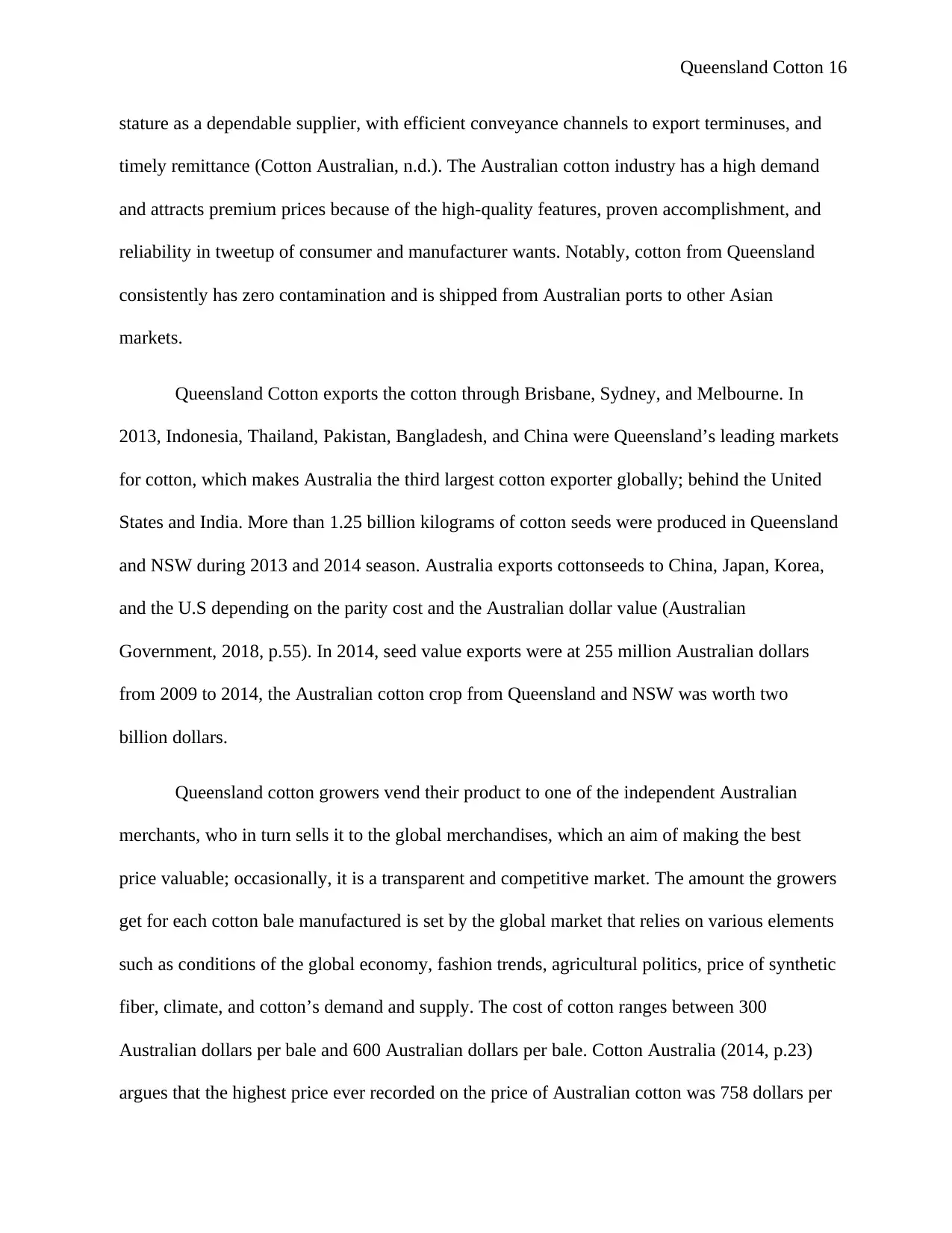
Queensland Cotton 16
stature as a dependable supplier, with efficient conveyance channels to export terminuses, and
timely remittance (Cotton Australian, n.d.). The Australian cotton industry has a high demand
and attracts premium prices because of the high-quality features, proven accomplishment, and
reliability in tweetup of consumer and manufacturer wants. Notably, cotton from Queensland
consistently has zero contamination and is shipped from Australian ports to other Asian
markets.
Queensland Cotton exports the cotton through Brisbane, Sydney, and Melbourne. In
2013, Indonesia, Thailand, Pakistan, Bangladesh, and China were Queensland’s leading markets
for cotton, which makes Australia the third largest cotton exporter globally; behind the United
States and India. More than 1.25 billion kilograms of cotton seeds were produced in Queensland
and NSW during 2013 and 2014 season. Australia exports cottonseeds to China, Japan, Korea,
and the U.S depending on the parity cost and the Australian dollar value (Australian
Government, 2018, p.55). In 2014, seed value exports were at 255 million Australian dollars
from 2009 to 2014, the Australian cotton crop from Queensland and NSW was worth two
billion dollars.
Queensland cotton growers vend their product to one of the independent Australian
merchants, who in turn sells it to the global merchandises, which an aim of making the best
price valuable; occasionally, it is a transparent and competitive market. The amount the growers
get for each cotton bale manufactured is set by the global market that relies on various elements
such as conditions of the global economy, fashion trends, agricultural politics, price of synthetic
fiber, climate, and cotton’s demand and supply. The cost of cotton ranges between 300
Australian dollars per bale and 600 Australian dollars per bale. Cotton Australia (2014, p.23)
argues that the highest price ever recorded on the price of Australian cotton was 758 dollars per
stature as a dependable supplier, with efficient conveyance channels to export terminuses, and
timely remittance (Cotton Australian, n.d.). The Australian cotton industry has a high demand
and attracts premium prices because of the high-quality features, proven accomplishment, and
reliability in tweetup of consumer and manufacturer wants. Notably, cotton from Queensland
consistently has zero contamination and is shipped from Australian ports to other Asian
markets.
Queensland Cotton exports the cotton through Brisbane, Sydney, and Melbourne. In
2013, Indonesia, Thailand, Pakistan, Bangladesh, and China were Queensland’s leading markets
for cotton, which makes Australia the third largest cotton exporter globally; behind the United
States and India. More than 1.25 billion kilograms of cotton seeds were produced in Queensland
and NSW during 2013 and 2014 season. Australia exports cottonseeds to China, Japan, Korea,
and the U.S depending on the parity cost and the Australian dollar value (Australian
Government, 2018, p.55). In 2014, seed value exports were at 255 million Australian dollars
from 2009 to 2014, the Australian cotton crop from Queensland and NSW was worth two
billion dollars.
Queensland cotton growers vend their product to one of the independent Australian
merchants, who in turn sells it to the global merchandises, which an aim of making the best
price valuable; occasionally, it is a transparent and competitive market. The amount the growers
get for each cotton bale manufactured is set by the global market that relies on various elements
such as conditions of the global economy, fashion trends, agricultural politics, price of synthetic
fiber, climate, and cotton’s demand and supply. The cost of cotton ranges between 300
Australian dollars per bale and 600 Australian dollars per bale. Cotton Australia (2014, p.23)
argues that the highest price ever recorded on the price of Australian cotton was 758 dollars per
Paraphrase This Document
Need a fresh take? Get an instant paraphrase of this document with our AI Paraphraser
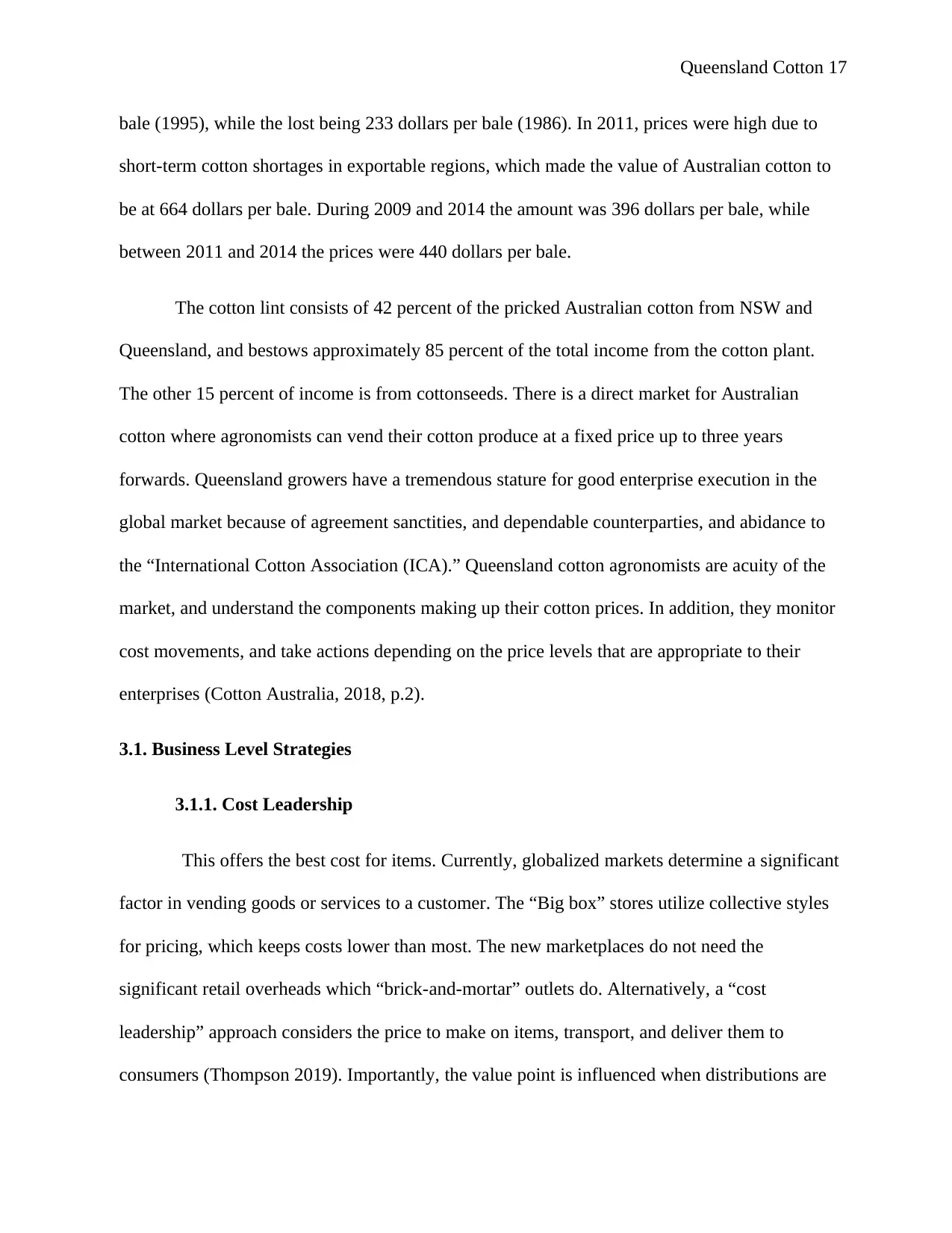
Queensland Cotton 17
bale (1995), while the lost being 233 dollars per bale (1986). In 2011, prices were high due to
short-term cotton shortages in exportable regions, which made the value of Australian cotton to
be at 664 dollars per bale. During 2009 and 2014 the amount was 396 dollars per bale, while
between 2011 and 2014 the prices were 440 dollars per bale.
The cotton lint consists of 42 percent of the pricked Australian cotton from NSW and
Queensland, and bestows approximately 85 percent of the total income from the cotton plant.
The other 15 percent of income is from cottonseeds. There is a direct market for Australian
cotton where agronomists can vend their cotton produce at a fixed price up to three years
forwards. Queensland growers have a tremendous stature for good enterprise execution in the
global market because of agreement sanctities, and dependable counterparties, and abidance to
the “International Cotton Association (ICA).” Queensland cotton agronomists are acuity of the
market, and understand the components making up their cotton prices. In addition, they monitor
cost movements, and take actions depending on the price levels that are appropriate to their
enterprises (Cotton Australia, 2018, p.2).
3.1. Business Level Strategies
3.1.1. Cost Leadership
This offers the best cost for items. Currently, globalized markets determine a significant
factor in vending goods or services to a customer. The “Big box” stores utilize collective styles
for pricing, which keeps costs lower than most. The new marketplaces do not need the
significant retail overheads which “brick-and-mortar” outlets do. Alternatively, a “cost
leadership” approach considers the price to make on items, transport, and deliver them to
consumers (Thompson 2019). Importantly, the value point is influenced when distributions are
bale (1995), while the lost being 233 dollars per bale (1986). In 2011, prices were high due to
short-term cotton shortages in exportable regions, which made the value of Australian cotton to
be at 664 dollars per bale. During 2009 and 2014 the amount was 396 dollars per bale, while
between 2011 and 2014 the prices were 440 dollars per bale.
The cotton lint consists of 42 percent of the pricked Australian cotton from NSW and
Queensland, and bestows approximately 85 percent of the total income from the cotton plant.
The other 15 percent of income is from cottonseeds. There is a direct market for Australian
cotton where agronomists can vend their cotton produce at a fixed price up to three years
forwards. Queensland growers have a tremendous stature for good enterprise execution in the
global market because of agreement sanctities, and dependable counterparties, and abidance to
the “International Cotton Association (ICA).” Queensland cotton agronomists are acuity of the
market, and understand the components making up their cotton prices. In addition, they monitor
cost movements, and take actions depending on the price levels that are appropriate to their
enterprises (Cotton Australia, 2018, p.2).
3.1. Business Level Strategies
3.1.1. Cost Leadership
This offers the best cost for items. Currently, globalized markets determine a significant
factor in vending goods or services to a customer. The “Big box” stores utilize collective styles
for pricing, which keeps costs lower than most. The new marketplaces do not need the
significant retail overheads which “brick-and-mortar” outlets do. Alternatively, a “cost
leadership” approach considers the price to make on items, transport, and deliver them to
consumers (Thompson 2019). Importantly, the value point is influenced when distributions are
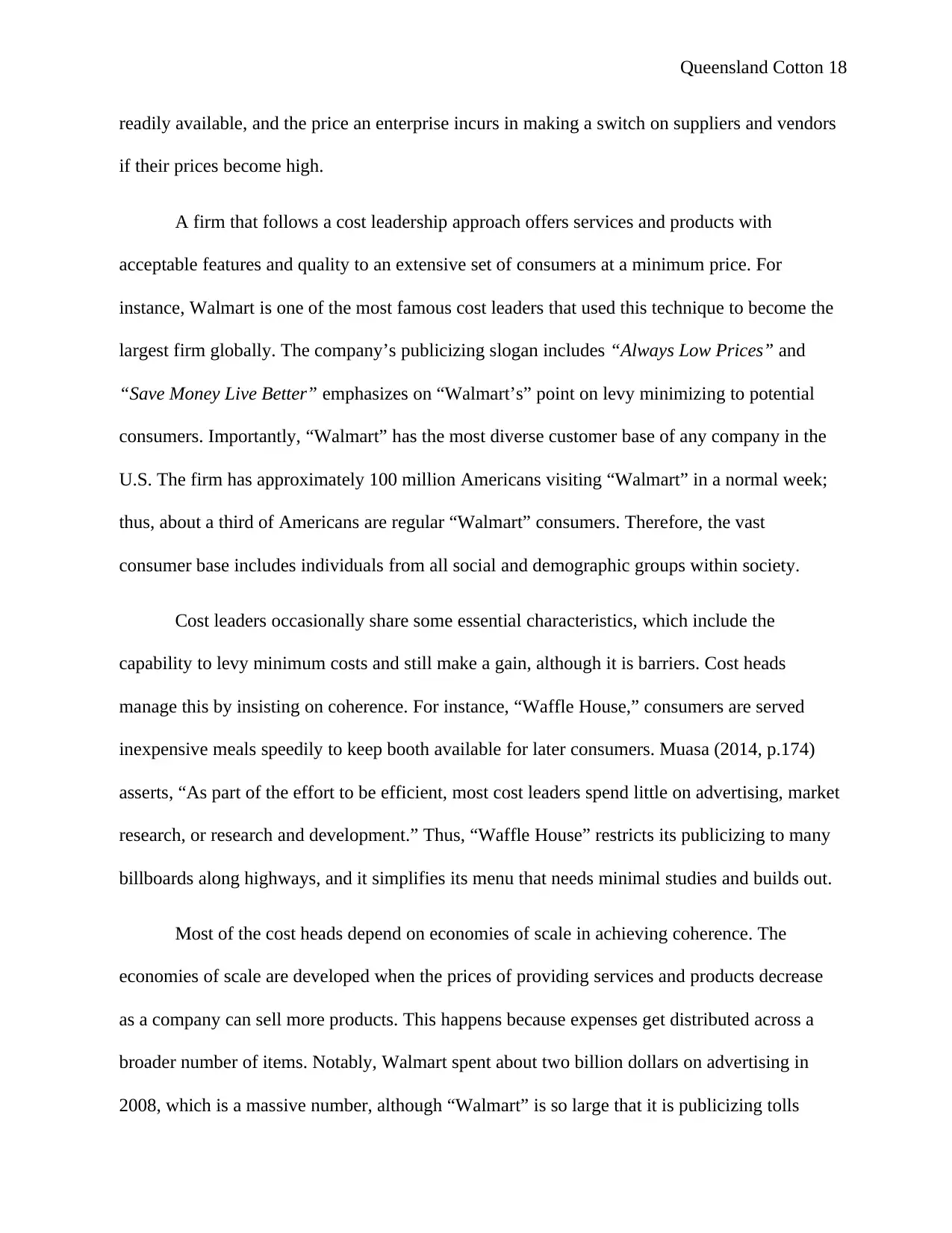
Queensland Cotton 18
readily available, and the price an enterprise incurs in making a switch on suppliers and vendors
if their prices become high.
A firm that follows a cost leadership approach offers services and products with
acceptable features and quality to an extensive set of consumers at a minimum price. For
instance, Walmart is one of the most famous cost leaders that used this technique to become the
largest firm globally. The company’s publicizing slogan includes “Always Low Prices” and
“Save Money Live Better” emphasizes on “Walmart’s” point on levy minimizing to potential
consumers. Importantly, “Walmart” has the most diverse customer base of any company in the
U.S. The firm has approximately 100 million Americans visiting “Walmart” in a normal week;
thus, about a third of Americans are regular “Walmart” consumers. Therefore, the vast
consumer base includes individuals from all social and demographic groups within society.
Cost leaders occasionally share some essential characteristics, which include the
capability to levy minimum costs and still make a gain, although it is barriers. Cost heads
manage this by insisting on coherence. For instance, “Waffle House,” consumers are served
inexpensive meals speedily to keep booth available for later consumers. Muasa (2014, p.174)
asserts, “As part of the effort to be efficient, most cost leaders spend little on advertising, market
research, or research and development.” Thus, “Waffle House” restricts its publicizing to many
billboards along highways, and it simplifies its menu that needs minimal studies and builds out.
Most of the cost heads depend on economies of scale in achieving coherence. The
economies of scale are developed when the prices of providing services and products decrease
as a company can sell more products. This happens because expenses get distributed across a
broader number of items. Notably, Walmart spent about two billion dollars on advertising in
2008, which is a massive number, although “Walmart” is so large that it is publicizing tolls
readily available, and the price an enterprise incurs in making a switch on suppliers and vendors
if their prices become high.
A firm that follows a cost leadership approach offers services and products with
acceptable features and quality to an extensive set of consumers at a minimum price. For
instance, Walmart is one of the most famous cost leaders that used this technique to become the
largest firm globally. The company’s publicizing slogan includes “Always Low Prices” and
“Save Money Live Better” emphasizes on “Walmart’s” point on levy minimizing to potential
consumers. Importantly, “Walmart” has the most diverse customer base of any company in the
U.S. The firm has approximately 100 million Americans visiting “Walmart” in a normal week;
thus, about a third of Americans are regular “Walmart” consumers. Therefore, the vast
consumer base includes individuals from all social and demographic groups within society.
Cost leaders occasionally share some essential characteristics, which include the
capability to levy minimum costs and still make a gain, although it is barriers. Cost heads
manage this by insisting on coherence. For instance, “Waffle House,” consumers are served
inexpensive meals speedily to keep booth available for later consumers. Muasa (2014, p.174)
asserts, “As part of the effort to be efficient, most cost leaders spend little on advertising, market
research, or research and development.” Thus, “Waffle House” restricts its publicizing to many
billboards along highways, and it simplifies its menu that needs minimal studies and builds out.
Most of the cost heads depend on economies of scale in achieving coherence. The
economies of scale are developed when the prices of providing services and products decrease
as a company can sell more products. This happens because expenses get distributed across a
broader number of items. Notably, Walmart spent about two billion dollars on advertising in
2008, which is a massive number, although “Walmart” is so large that it is publicizing tolls
You're viewing a preview
Unlock full access by subscribing today!
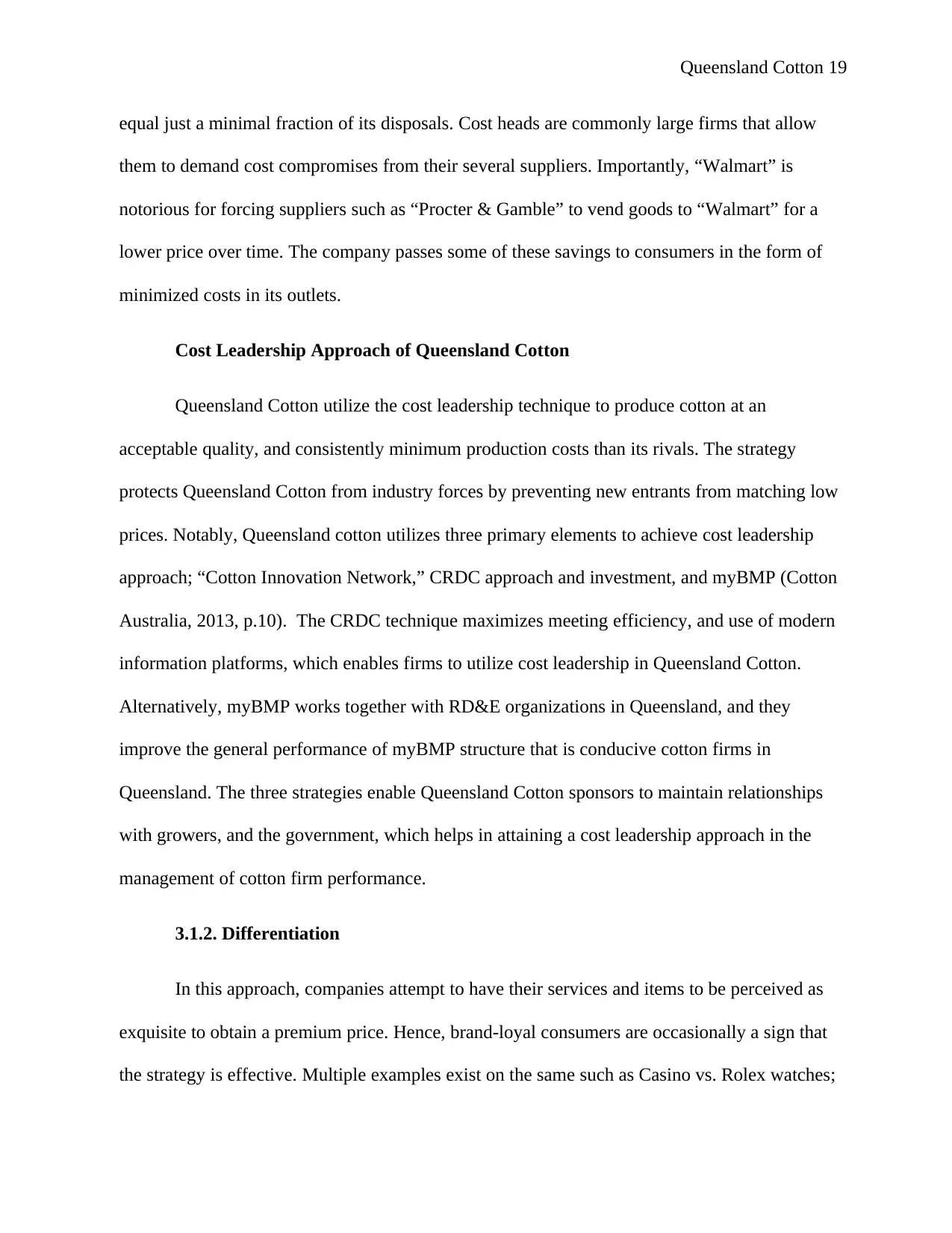
Queensland Cotton 19
equal just a minimal fraction of its disposals. Cost heads are commonly large firms that allow
them to demand cost compromises from their several suppliers. Importantly, “Walmart” is
notorious for forcing suppliers such as “Procter & Gamble” to vend goods to “Walmart” for a
lower price over time. The company passes some of these savings to consumers in the form of
minimized costs in its outlets.
Cost Leadership Approach of Queensland Cotton
Queensland Cotton utilize the cost leadership technique to produce cotton at an
acceptable quality, and consistently minimum production costs than its rivals. The strategy
protects Queensland Cotton from industry forces by preventing new entrants from matching low
prices. Notably, Queensland cotton utilizes three primary elements to achieve cost leadership
approach; “Cotton Innovation Network,” CRDC approach and investment, and myBMP (Cotton
Australia, 2013, p.10). The CRDC technique maximizes meeting efficiency, and use of modern
information platforms, which enables firms to utilize cost leadership in Queensland Cotton.
Alternatively, myBMP works together with RD&E organizations in Queensland, and they
improve the general performance of myBMP structure that is conducive cotton firms in
Queensland. The three strategies enable Queensland Cotton sponsors to maintain relationships
with growers, and the government, which helps in attaining a cost leadership approach in the
management of cotton firm performance.
3.1.2. Differentiation
In this approach, companies attempt to have their services and items to be perceived as
exquisite to obtain a premium price. Hence, brand-loyal consumers are occasionally a sign that
the strategy is effective. Multiple examples exist on the same such as Casino vs. Rolex watches;
equal just a minimal fraction of its disposals. Cost heads are commonly large firms that allow
them to demand cost compromises from their several suppliers. Importantly, “Walmart” is
notorious for forcing suppliers such as “Procter & Gamble” to vend goods to “Walmart” for a
lower price over time. The company passes some of these savings to consumers in the form of
minimized costs in its outlets.
Cost Leadership Approach of Queensland Cotton
Queensland Cotton utilize the cost leadership technique to produce cotton at an
acceptable quality, and consistently minimum production costs than its rivals. The strategy
protects Queensland Cotton from industry forces by preventing new entrants from matching low
prices. Notably, Queensland cotton utilizes three primary elements to achieve cost leadership
approach; “Cotton Innovation Network,” CRDC approach and investment, and myBMP (Cotton
Australia, 2013, p.10). The CRDC technique maximizes meeting efficiency, and use of modern
information platforms, which enables firms to utilize cost leadership in Queensland Cotton.
Alternatively, myBMP works together with RD&E organizations in Queensland, and they
improve the general performance of myBMP structure that is conducive cotton firms in
Queensland. The three strategies enable Queensland Cotton sponsors to maintain relationships
with growers, and the government, which helps in attaining a cost leadership approach in the
management of cotton firm performance.
3.1.2. Differentiation
In this approach, companies attempt to have their services and items to be perceived as
exquisite to obtain a premium price. Hence, brand-loyal consumers are occasionally a sign that
the strategy is effective. Multiple examples exist on the same such as Casino vs. Rolex watches;
Paraphrase This Document
Need a fresh take? Get an instant paraphrase of this document with our AI Paraphraser
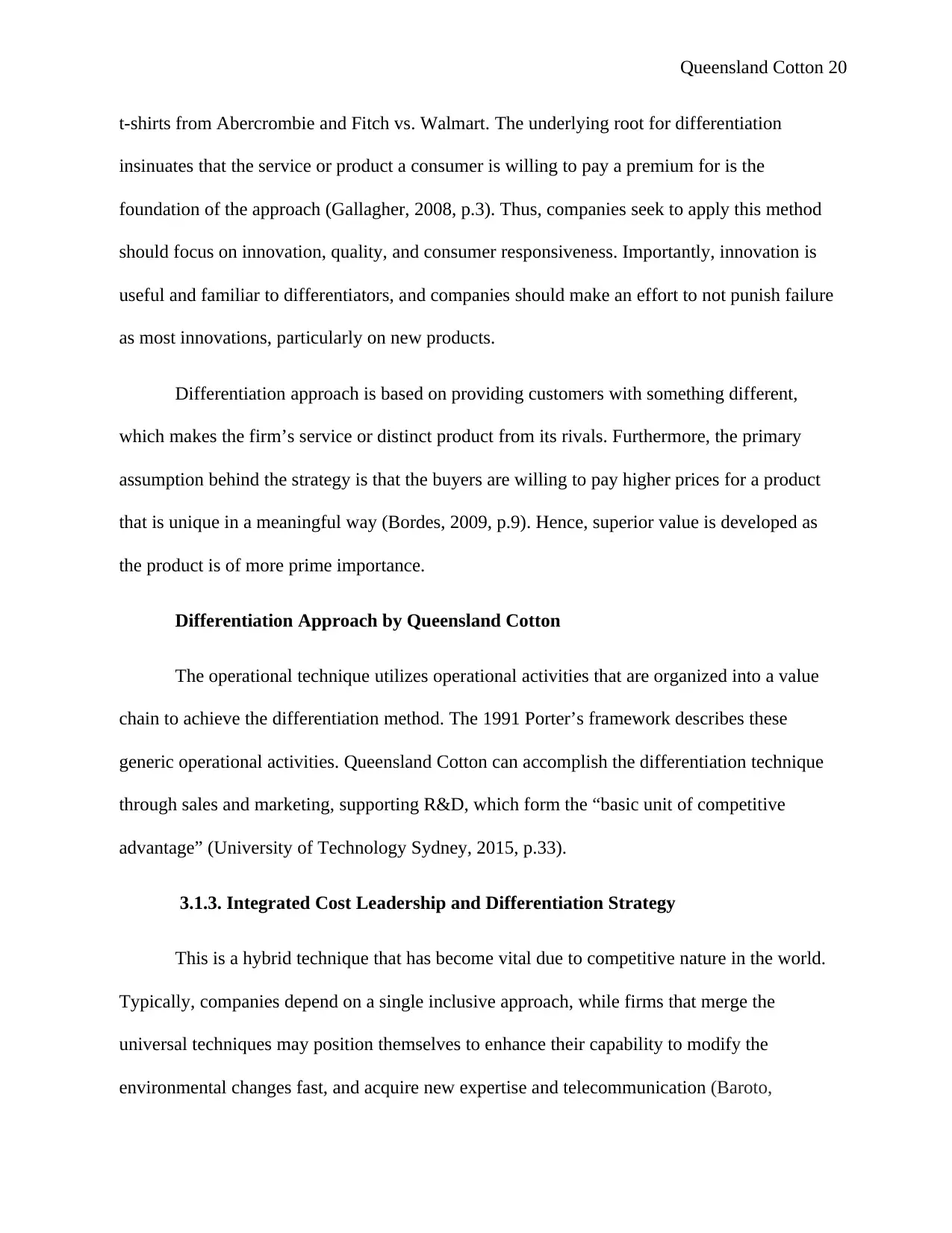
Queensland Cotton 20
t-shirts from Abercrombie and Fitch vs. Walmart. The underlying root for differentiation
insinuates that the service or product a consumer is willing to pay a premium for is the
foundation of the approach (Gallagher, 2008, p.3). Thus, companies seek to apply this method
should focus on innovation, quality, and consumer responsiveness. Importantly, innovation is
useful and familiar to differentiators, and companies should make an effort to not punish failure
as most innovations, particularly on new products.
Differentiation approach is based on providing customers with something different,
which makes the firm’s service or distinct product from its rivals. Furthermore, the primary
assumption behind the strategy is that the buyers are willing to pay higher prices for a product
that is unique in a meaningful way (Bordes, 2009, p.9). Hence, superior value is developed as
the product is of more prime importance.
Differentiation Approach by Queensland Cotton
The operational technique utilizes operational activities that are organized into a value
chain to achieve the differentiation method. The 1991 Porter’s framework describes these
generic operational activities. Queensland Cotton can accomplish the differentiation technique
through sales and marketing, supporting R&D, which form the “basic unit of competitive
advantage” (University of Technology Sydney, 2015, p.33).
3.1.3. Integrated Cost Leadership and Differentiation Strategy
This is a hybrid technique that has become vital due to competitive nature in the world.
Typically, companies depend on a single inclusive approach, while firms that merge the
universal techniques may position themselves to enhance their capability to modify the
environmental changes fast, and acquire new expertise and telecommunication (Baroto,
t-shirts from Abercrombie and Fitch vs. Walmart. The underlying root for differentiation
insinuates that the service or product a consumer is willing to pay a premium for is the
foundation of the approach (Gallagher, 2008, p.3). Thus, companies seek to apply this method
should focus on innovation, quality, and consumer responsiveness. Importantly, innovation is
useful and familiar to differentiators, and companies should make an effort to not punish failure
as most innovations, particularly on new products.
Differentiation approach is based on providing customers with something different,
which makes the firm’s service or distinct product from its rivals. Furthermore, the primary
assumption behind the strategy is that the buyers are willing to pay higher prices for a product
that is unique in a meaningful way (Bordes, 2009, p.9). Hence, superior value is developed as
the product is of more prime importance.
Differentiation Approach by Queensland Cotton
The operational technique utilizes operational activities that are organized into a value
chain to achieve the differentiation method. The 1991 Porter’s framework describes these
generic operational activities. Queensland Cotton can accomplish the differentiation technique
through sales and marketing, supporting R&D, which form the “basic unit of competitive
advantage” (University of Technology Sydney, 2015, p.33).
3.1.3. Integrated Cost Leadership and Differentiation Strategy
This is a hybrid technique that has become vital due to competitive nature in the world.
Typically, companies depend on a single inclusive approach, while firms that merge the
universal techniques may position themselves to enhance their capability to modify the
environmental changes fast, and acquire new expertise and telecommunication (Baroto,
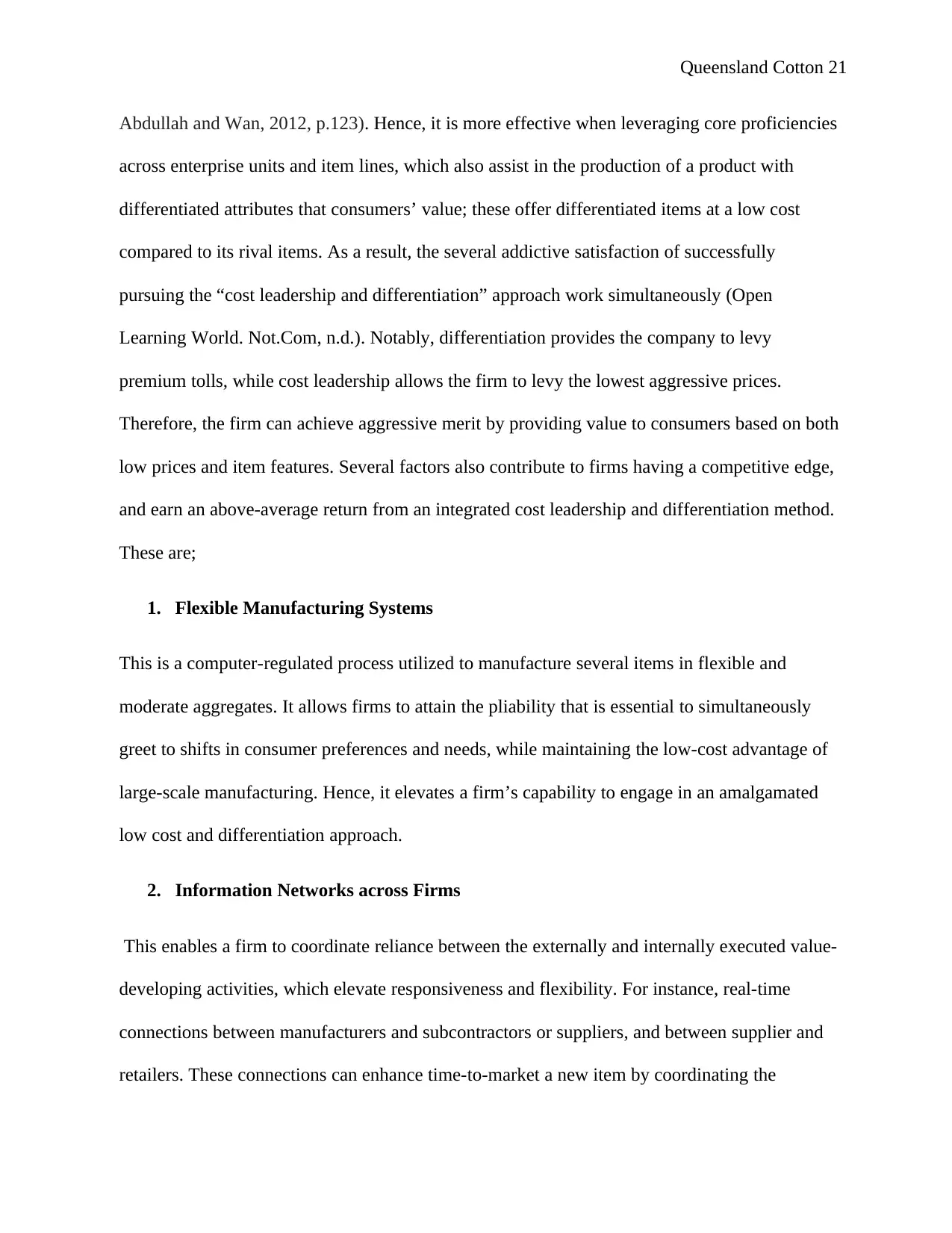
Queensland Cotton 21
Abdullah and Wan, 2012, p.123). Hence, it is more effective when leveraging core proficiencies
across enterprise units and item lines, which also assist in the production of a product with
differentiated attributes that consumers’ value; these offer differentiated items at a low cost
compared to its rival items. As a result, the several addictive satisfaction of successfully
pursuing the “cost leadership and differentiation” approach work simultaneously (Open
Learning World. Not.Com, n.d.). Notably, differentiation provides the company to levy
premium tolls, while cost leadership allows the firm to levy the lowest aggressive prices.
Therefore, the firm can achieve aggressive merit by providing value to consumers based on both
low prices and item features. Several factors also contribute to firms having a competitive edge,
and earn an above-average return from an integrated cost leadership and differentiation method.
These are;
1. Flexible Manufacturing Systems
This is a computer-regulated process utilized to manufacture several items in flexible and
moderate aggregates. It allows firms to attain the pliability that is essential to simultaneously
greet to shifts in consumer preferences and needs, while maintaining the low-cost advantage of
large-scale manufacturing. Hence, it elevates a firm’s capability to engage in an amalgamated
low cost and differentiation approach.
2. Information Networks across Firms
This enables a firm to coordinate reliance between the externally and internally executed value-
developing activities, which elevate responsiveness and flexibility. For instance, real-time
connections between manufacturers and subcontractors or suppliers, and between supplier and
retailers. These connections can enhance time-to-market a new item by coordinating the
Abdullah and Wan, 2012, p.123). Hence, it is more effective when leveraging core proficiencies
across enterprise units and item lines, which also assist in the production of a product with
differentiated attributes that consumers’ value; these offer differentiated items at a low cost
compared to its rival items. As a result, the several addictive satisfaction of successfully
pursuing the “cost leadership and differentiation” approach work simultaneously (Open
Learning World. Not.Com, n.d.). Notably, differentiation provides the company to levy
premium tolls, while cost leadership allows the firm to levy the lowest aggressive prices.
Therefore, the firm can achieve aggressive merit by providing value to consumers based on both
low prices and item features. Several factors also contribute to firms having a competitive edge,
and earn an above-average return from an integrated cost leadership and differentiation method.
These are;
1. Flexible Manufacturing Systems
This is a computer-regulated process utilized to manufacture several items in flexible and
moderate aggregates. It allows firms to attain the pliability that is essential to simultaneously
greet to shifts in consumer preferences and needs, while maintaining the low-cost advantage of
large-scale manufacturing. Hence, it elevates a firm’s capability to engage in an amalgamated
low cost and differentiation approach.
2. Information Networks across Firms
This enables a firm to coordinate reliance between the externally and internally executed value-
developing activities, which elevate responsiveness and flexibility. For instance, real-time
connections between manufacturers and subcontractors or suppliers, and between supplier and
retailers. These connections can enhance time-to-market a new item by coordinating the
You're viewing a preview
Unlock full access by subscribing today!
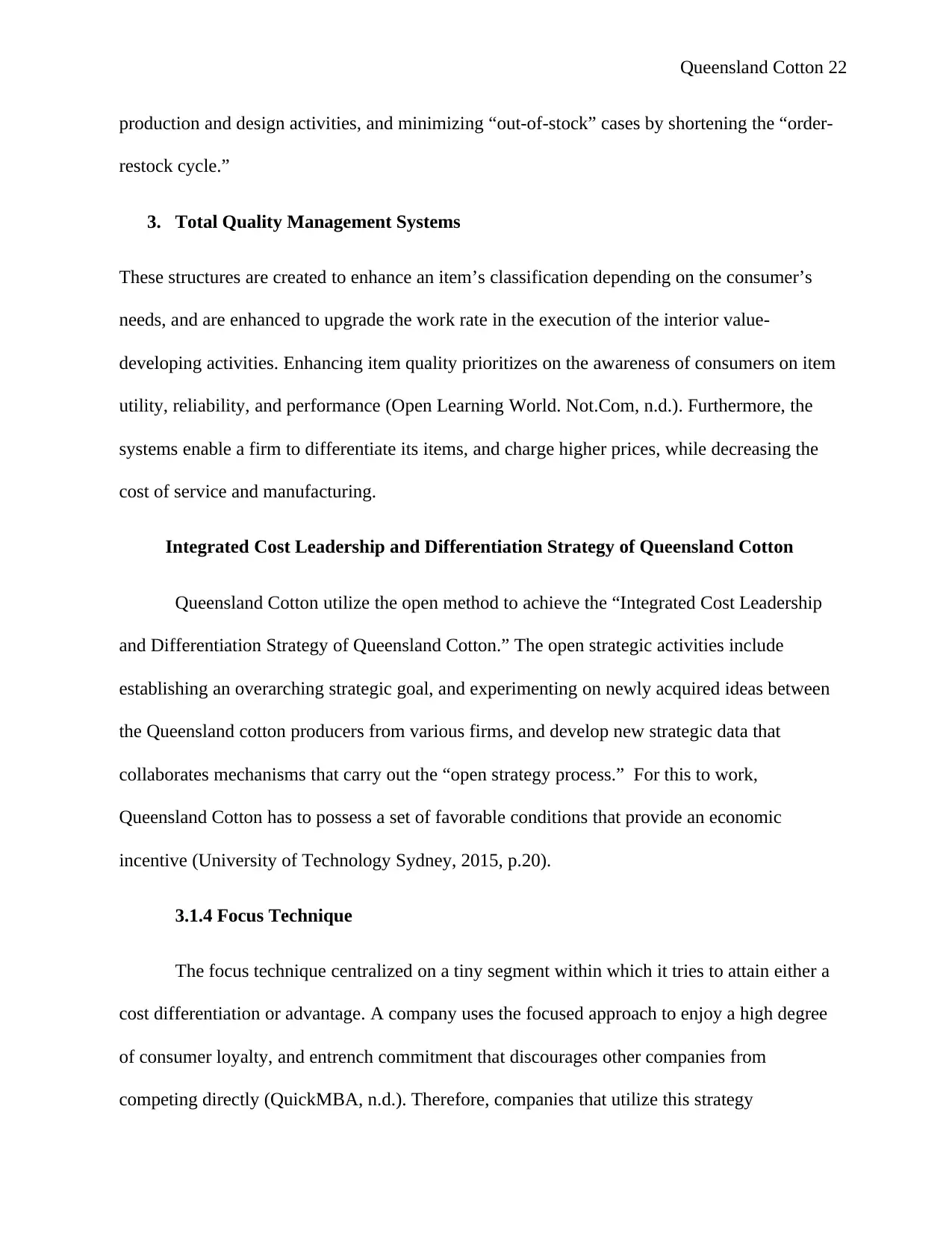
Queensland Cotton 22
production and design activities, and minimizing “out-of-stock” cases by shortening the “order-
restock cycle.”
3. Total Quality Management Systems
These structures are created to enhance an item’s classification depending on the consumer’s
needs, and are enhanced to upgrade the work rate in the execution of the interior value-
developing activities. Enhancing item quality prioritizes on the awareness of consumers on item
utility, reliability, and performance (Open Learning World. Not.Com, n.d.). Furthermore, the
systems enable a firm to differentiate its items, and charge higher prices, while decreasing the
cost of service and manufacturing.
Integrated Cost Leadership and Differentiation Strategy of Queensland Cotton
Queensland Cotton utilize the open method to achieve the “Integrated Cost Leadership
and Differentiation Strategy of Queensland Cotton.” The open strategic activities include
establishing an overarching strategic goal, and experimenting on newly acquired ideas between
the Queensland cotton producers from various firms, and develop new strategic data that
collaborates mechanisms that carry out the “open strategy process.” For this to work,
Queensland Cotton has to possess a set of favorable conditions that provide an economic
incentive (University of Technology Sydney, 2015, p.20).
3.1.4 Focus Technique
The focus technique centralized on a tiny segment within which it tries to attain either a
cost differentiation or advantage. A company uses the focused approach to enjoy a high degree
of consumer loyalty, and entrench commitment that discourages other companies from
competing directly (QuickMBA, n.d.). Therefore, companies that utilize this strategy
production and design activities, and minimizing “out-of-stock” cases by shortening the “order-
restock cycle.”
3. Total Quality Management Systems
These structures are created to enhance an item’s classification depending on the consumer’s
needs, and are enhanced to upgrade the work rate in the execution of the interior value-
developing activities. Enhancing item quality prioritizes on the awareness of consumers on item
utility, reliability, and performance (Open Learning World. Not.Com, n.d.). Furthermore, the
systems enable a firm to differentiate its items, and charge higher prices, while decreasing the
cost of service and manufacturing.
Integrated Cost Leadership and Differentiation Strategy of Queensland Cotton
Queensland Cotton utilize the open method to achieve the “Integrated Cost Leadership
and Differentiation Strategy of Queensland Cotton.” The open strategic activities include
establishing an overarching strategic goal, and experimenting on newly acquired ideas between
the Queensland cotton producers from various firms, and develop new strategic data that
collaborates mechanisms that carry out the “open strategy process.” For this to work,
Queensland Cotton has to possess a set of favorable conditions that provide an economic
incentive (University of Technology Sydney, 2015, p.20).
3.1.4 Focus Technique
The focus technique centralized on a tiny segment within which it tries to attain either a
cost differentiation or advantage. A company uses the focused approach to enjoy a high degree
of consumer loyalty, and entrench commitment that discourages other companies from
competing directly (QuickMBA, n.d.). Therefore, companies that utilize this strategy
Paraphrase This Document
Need a fresh take? Get an instant paraphrase of this document with our AI Paraphraser
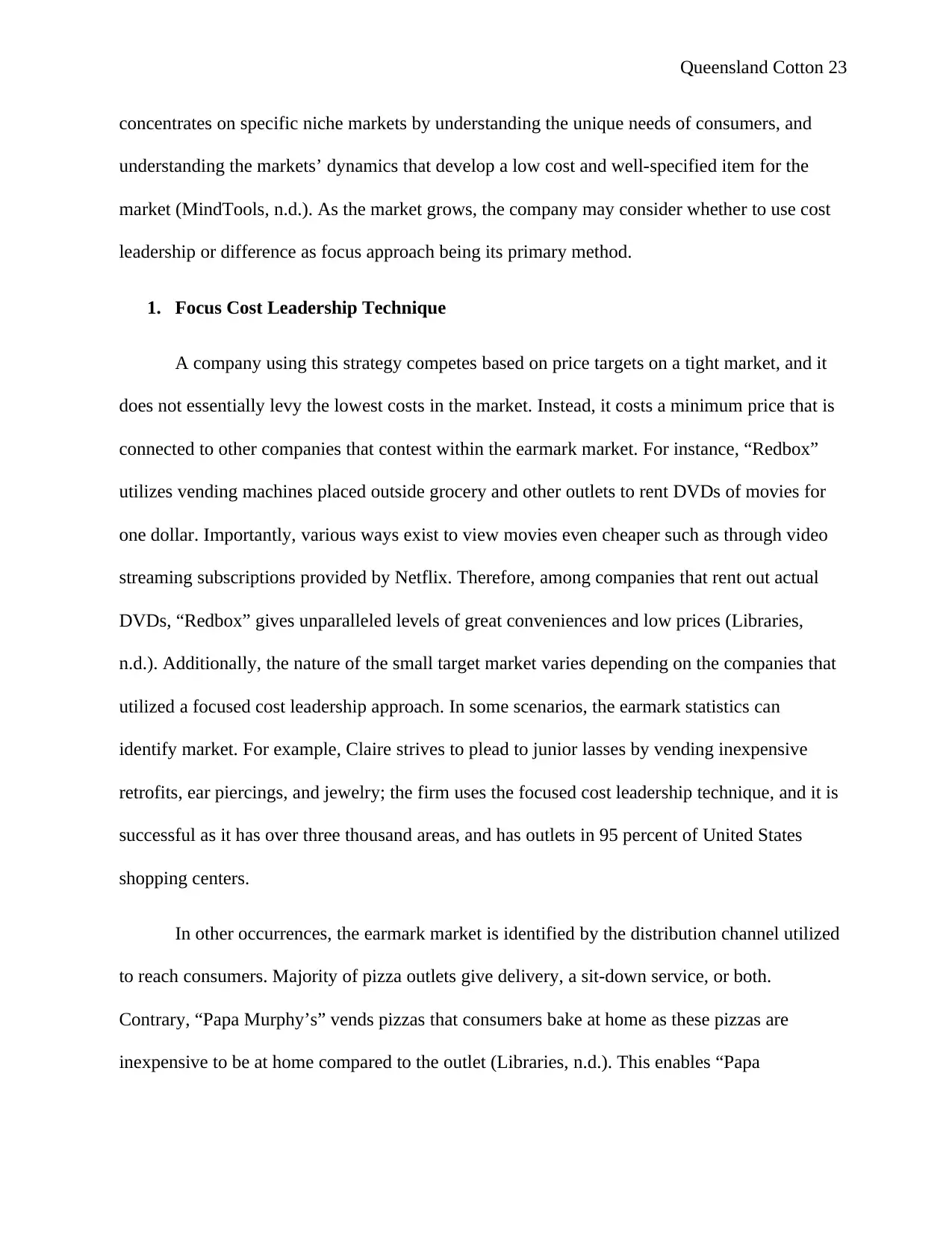
Queensland Cotton 23
concentrates on specific niche markets by understanding the unique needs of consumers, and
understanding the markets’ dynamics that develop a low cost and well-specified item for the
market (MindTools, n.d.). As the market grows, the company may consider whether to use cost
leadership or difference as focus approach being its primary method.
1. Focus Cost Leadership Technique
A company using this strategy competes based on price targets on a tight market, and it
does not essentially levy the lowest costs in the market. Instead, it costs a minimum price that is
connected to other companies that contest within the earmark market. For instance, “Redbox”
utilizes vending machines placed outside grocery and other outlets to rent DVDs of movies for
one dollar. Importantly, various ways exist to view movies even cheaper such as through video
streaming subscriptions provided by Netflix. Therefore, among companies that rent out actual
DVDs, “Redbox” gives unparalleled levels of great conveniences and low prices (Libraries,
n.d.). Additionally, the nature of the small target market varies depending on the companies that
utilized a focused cost leadership approach. In some scenarios, the earmark statistics can
identify market. For example, Claire strives to plead to junior lasses by vending inexpensive
retrofits, ear piercings, and jewelry; the firm uses the focused cost leadership technique, and it is
successful as it has over three thousand areas, and has outlets in 95 percent of United States
shopping centers.
In other occurrences, the earmark market is identified by the distribution channel utilized
to reach consumers. Majority of pizza outlets give delivery, a sit-down service, or both.
Contrary, “Papa Murphy’s” vends pizzas that consumers bake at home as these pizzas are
inexpensive to be at home compared to the outlet (Libraries, n.d.). This enables “Papa
concentrates on specific niche markets by understanding the unique needs of consumers, and
understanding the markets’ dynamics that develop a low cost and well-specified item for the
market (MindTools, n.d.). As the market grows, the company may consider whether to use cost
leadership or difference as focus approach being its primary method.
1. Focus Cost Leadership Technique
A company using this strategy competes based on price targets on a tight market, and it
does not essentially levy the lowest costs in the market. Instead, it costs a minimum price that is
connected to other companies that contest within the earmark market. For instance, “Redbox”
utilizes vending machines placed outside grocery and other outlets to rent DVDs of movies for
one dollar. Importantly, various ways exist to view movies even cheaper such as through video
streaming subscriptions provided by Netflix. Therefore, among companies that rent out actual
DVDs, “Redbox” gives unparalleled levels of great conveniences and low prices (Libraries,
n.d.). Additionally, the nature of the small target market varies depending on the companies that
utilized a focused cost leadership approach. In some scenarios, the earmark statistics can
identify market. For example, Claire strives to plead to junior lasses by vending inexpensive
retrofits, ear piercings, and jewelry; the firm uses the focused cost leadership technique, and it is
successful as it has over three thousand areas, and has outlets in 95 percent of United States
shopping centers.
In other occurrences, the earmark market is identified by the distribution channel utilized
to reach consumers. Majority of pizza outlets give delivery, a sit-down service, or both.
Contrary, “Papa Murphy’s” vends pizzas that consumers bake at home as these pizzas are
inexpensive to be at home compared to the outlet (Libraries, n.d.). This enables “Papa
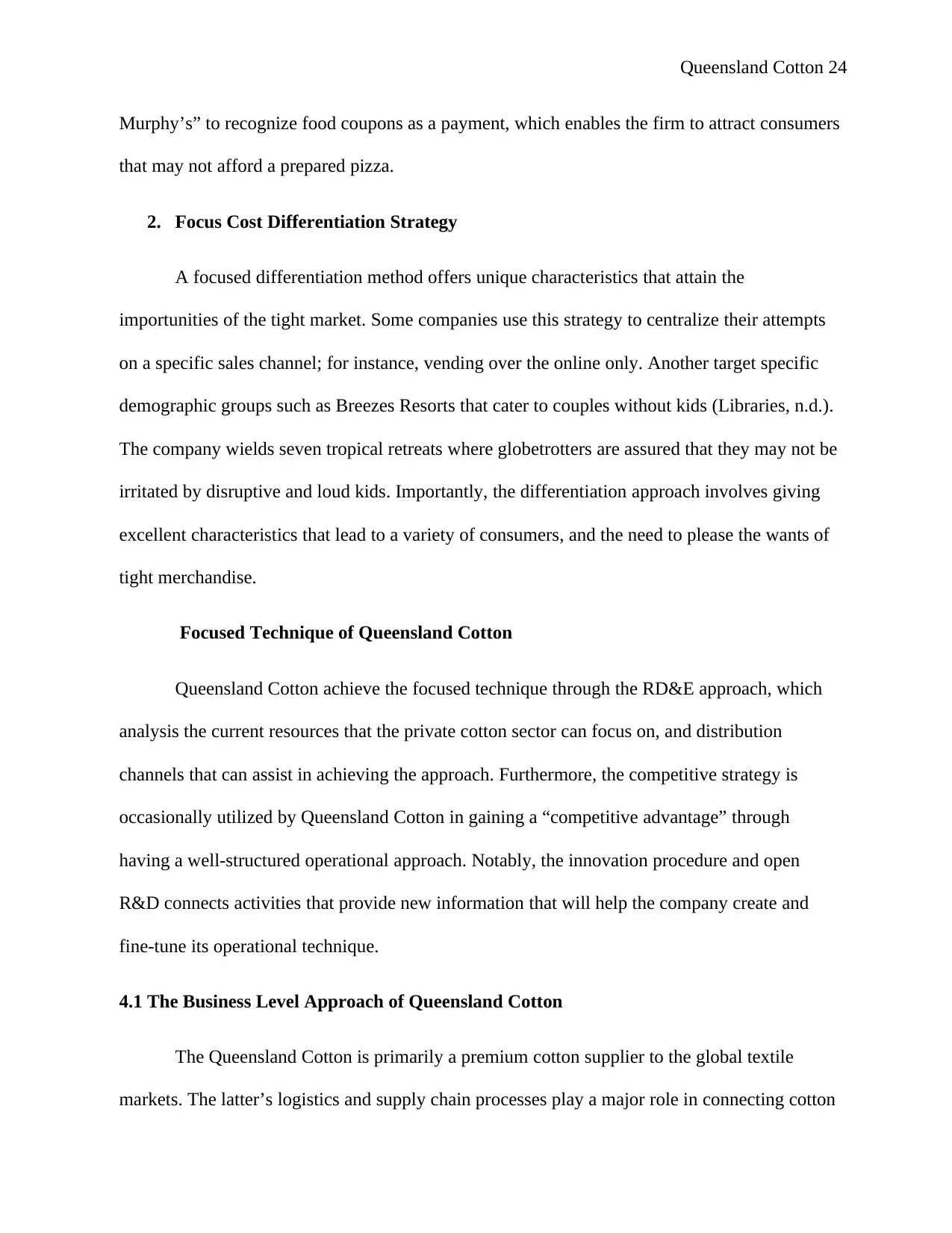
Queensland Cotton 24
Murphy’s” to recognize food coupons as a payment, which enables the firm to attract consumers
that may not afford a prepared pizza.
2. Focus Cost Differentiation Strategy
A focused differentiation method offers unique characteristics that attain the
importunities of the tight market. Some companies use this strategy to centralize their attempts
on a specific sales channel; for instance, vending over the online only. Another target specific
demographic groups such as Breezes Resorts that cater to couples without kids (Libraries, n.d.).
The company wields seven tropical retreats where globetrotters are assured that they may not be
irritated by disruptive and loud kids. Importantly, the differentiation approach involves giving
excellent characteristics that lead to a variety of consumers, and the need to please the wants of
tight merchandise.
Focused Technique of Queensland Cotton
Queensland Cotton achieve the focused technique through the RD&E approach, which
analysis the current resources that the private cotton sector can focus on, and distribution
channels that can assist in achieving the approach. Furthermore, the competitive strategy is
occasionally utilized by Queensland Cotton in gaining a “competitive advantage” through
having a well-structured operational approach. Notably, the innovation procedure and open
R&D connects activities that provide new information that will help the company create and
fine-tune its operational technique.
4.1 The Business Level Approach of Queensland Cotton
The Queensland Cotton is primarily a premium cotton supplier to the global textile
markets. The latter’s logistics and supply chain processes play a major role in connecting cotton
Murphy’s” to recognize food coupons as a payment, which enables the firm to attract consumers
that may not afford a prepared pizza.
2. Focus Cost Differentiation Strategy
A focused differentiation method offers unique characteristics that attain the
importunities of the tight market. Some companies use this strategy to centralize their attempts
on a specific sales channel; for instance, vending over the online only. Another target specific
demographic groups such as Breezes Resorts that cater to couples without kids (Libraries, n.d.).
The company wields seven tropical retreats where globetrotters are assured that they may not be
irritated by disruptive and loud kids. Importantly, the differentiation approach involves giving
excellent characteristics that lead to a variety of consumers, and the need to please the wants of
tight merchandise.
Focused Technique of Queensland Cotton
Queensland Cotton achieve the focused technique through the RD&E approach, which
analysis the current resources that the private cotton sector can focus on, and distribution
channels that can assist in achieving the approach. Furthermore, the competitive strategy is
occasionally utilized by Queensland Cotton in gaining a “competitive advantage” through
having a well-structured operational approach. Notably, the innovation procedure and open
R&D connects activities that provide new information that will help the company create and
fine-tune its operational technique.
4.1 The Business Level Approach of Queensland Cotton
The Queensland Cotton is primarily a premium cotton supplier to the global textile
markets. The latter’s logistics and supply chain processes play a major role in connecting cotton
You're viewing a preview
Unlock full access by subscribing today!
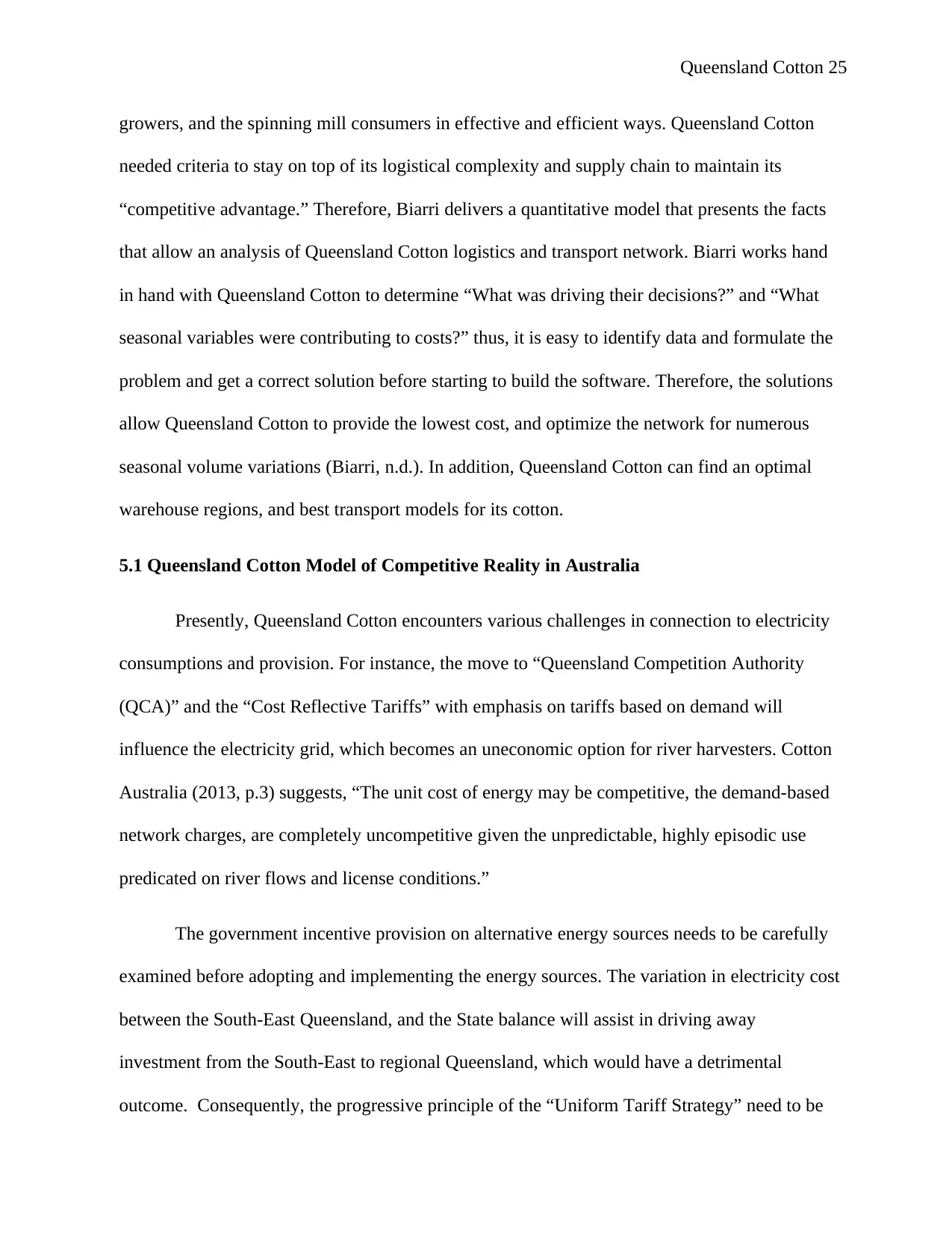
Queensland Cotton 25
growers, and the spinning mill consumers in effective and efficient ways. Queensland Cotton
needed criteria to stay on top of its logistical complexity and supply chain to maintain its
“competitive advantage.” Therefore, Biarri delivers a quantitative model that presents the facts
that allow an analysis of Queensland Cotton logistics and transport network. Biarri works hand
in hand with Queensland Cotton to determine “What was driving their decisions?” and “What
seasonal variables were contributing to costs?” thus, it is easy to identify data and formulate the
problem and get a correct solution before starting to build the software. Therefore, the solutions
allow Queensland Cotton to provide the lowest cost, and optimize the network for numerous
seasonal volume variations (Biarri, n.d.). In addition, Queensland Cotton can find an optimal
warehouse regions, and best transport models for its cotton.
5.1 Queensland Cotton Model of Competitive Reality in Australia
Presently, Queensland Cotton encounters various challenges in connection to electricity
consumptions and provision. For instance, the move to “Queensland Competition Authority
(QCA)” and the “Cost Reflective Tariffs” with emphasis on tariffs based on demand will
influence the electricity grid, which becomes an uneconomic option for river harvesters. Cotton
Australia (2013, p.3) suggests, “The unit cost of energy may be competitive, the demand-based
network charges, are completely uncompetitive given the unpredictable, highly episodic use
predicated on river flows and license conditions.”
The government incentive provision on alternative energy sources needs to be carefully
examined before adopting and implementing the energy sources. The variation in electricity cost
between the South-East Queensland, and the State balance will assist in driving away
investment from the South-East to regional Queensland, which would have a detrimental
outcome. Consequently, the progressive principle of the “Uniform Tariff Strategy” need to be
growers, and the spinning mill consumers in effective and efficient ways. Queensland Cotton
needed criteria to stay on top of its logistical complexity and supply chain to maintain its
“competitive advantage.” Therefore, Biarri delivers a quantitative model that presents the facts
that allow an analysis of Queensland Cotton logistics and transport network. Biarri works hand
in hand with Queensland Cotton to determine “What was driving their decisions?” and “What
seasonal variables were contributing to costs?” thus, it is easy to identify data and formulate the
problem and get a correct solution before starting to build the software. Therefore, the solutions
allow Queensland Cotton to provide the lowest cost, and optimize the network for numerous
seasonal volume variations (Biarri, n.d.). In addition, Queensland Cotton can find an optimal
warehouse regions, and best transport models for its cotton.
5.1 Queensland Cotton Model of Competitive Reality in Australia
Presently, Queensland Cotton encounters various challenges in connection to electricity
consumptions and provision. For instance, the move to “Queensland Competition Authority
(QCA)” and the “Cost Reflective Tariffs” with emphasis on tariffs based on demand will
influence the electricity grid, which becomes an uneconomic option for river harvesters. Cotton
Australia (2013, p.3) suggests, “The unit cost of energy may be competitive, the demand-based
network charges, are completely uncompetitive given the unpredictable, highly episodic use
predicated on river flows and license conditions.”
The government incentive provision on alternative energy sources needs to be carefully
examined before adopting and implementing the energy sources. The variation in electricity cost
between the South-East Queensland, and the State balance will assist in driving away
investment from the South-East to regional Queensland, which would have a detrimental
outcome. Consequently, the progressive principle of the “Uniform Tariff Strategy” need to be
Paraphrase This Document
Need a fresh take? Get an instant paraphrase of this document with our AI Paraphraser
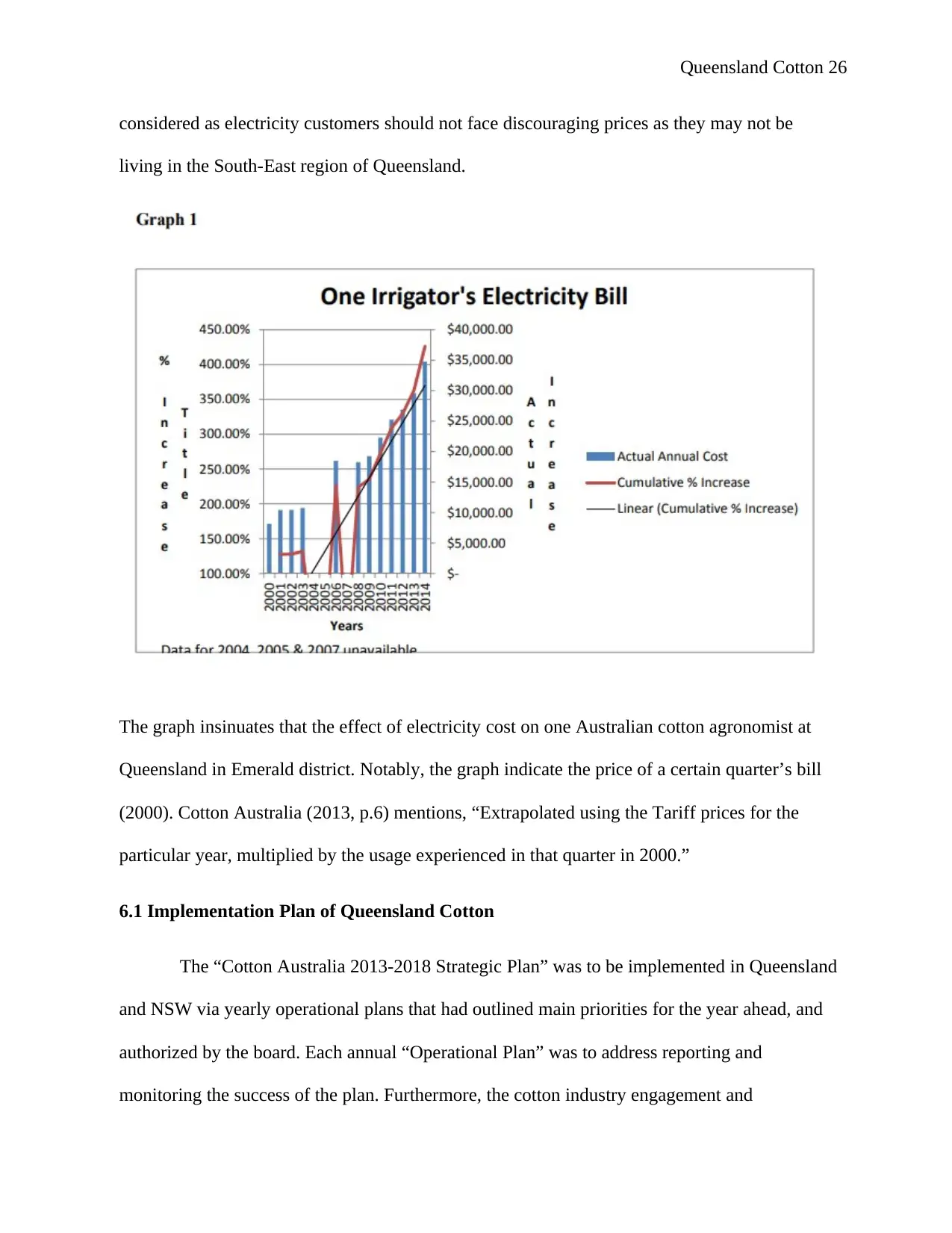
Queensland Cotton 26
considered as electricity customers should not face discouraging prices as they may not be
living in the South-East region of Queensland.
The graph insinuates that the effect of electricity cost on one Australian cotton agronomist at
Queensland in Emerald district. Notably, the graph indicate the price of a certain quarter’s bill
(2000). Cotton Australia (2013, p.6) mentions, “Extrapolated using the Tariff prices for the
particular year, multiplied by the usage experienced in that quarter in 2000.”
6.1 Implementation Plan of Queensland Cotton
The “Cotton Australia 2013-2018 Strategic Plan” was to be implemented in Queensland
and NSW via yearly operational plans that had outlined main priorities for the year ahead, and
authorized by the board. Each annual “Operational Plan” was to address reporting and
monitoring the success of the plan. Furthermore, the cotton industry engagement and
considered as electricity customers should not face discouraging prices as they may not be
living in the South-East region of Queensland.
The graph insinuates that the effect of electricity cost on one Australian cotton agronomist at
Queensland in Emerald district. Notably, the graph indicate the price of a certain quarter’s bill
(2000). Cotton Australia (2013, p.6) mentions, “Extrapolated using the Tariff prices for the
particular year, multiplied by the usage experienced in that quarter in 2000.”
6.1 Implementation Plan of Queensland Cotton
The “Cotton Australia 2013-2018 Strategic Plan” was to be implemented in Queensland
and NSW via yearly operational plans that had outlined main priorities for the year ahead, and
authorized by the board. Each annual “Operational Plan” was to address reporting and
monitoring the success of the plan. Furthermore, the cotton industry engagement and
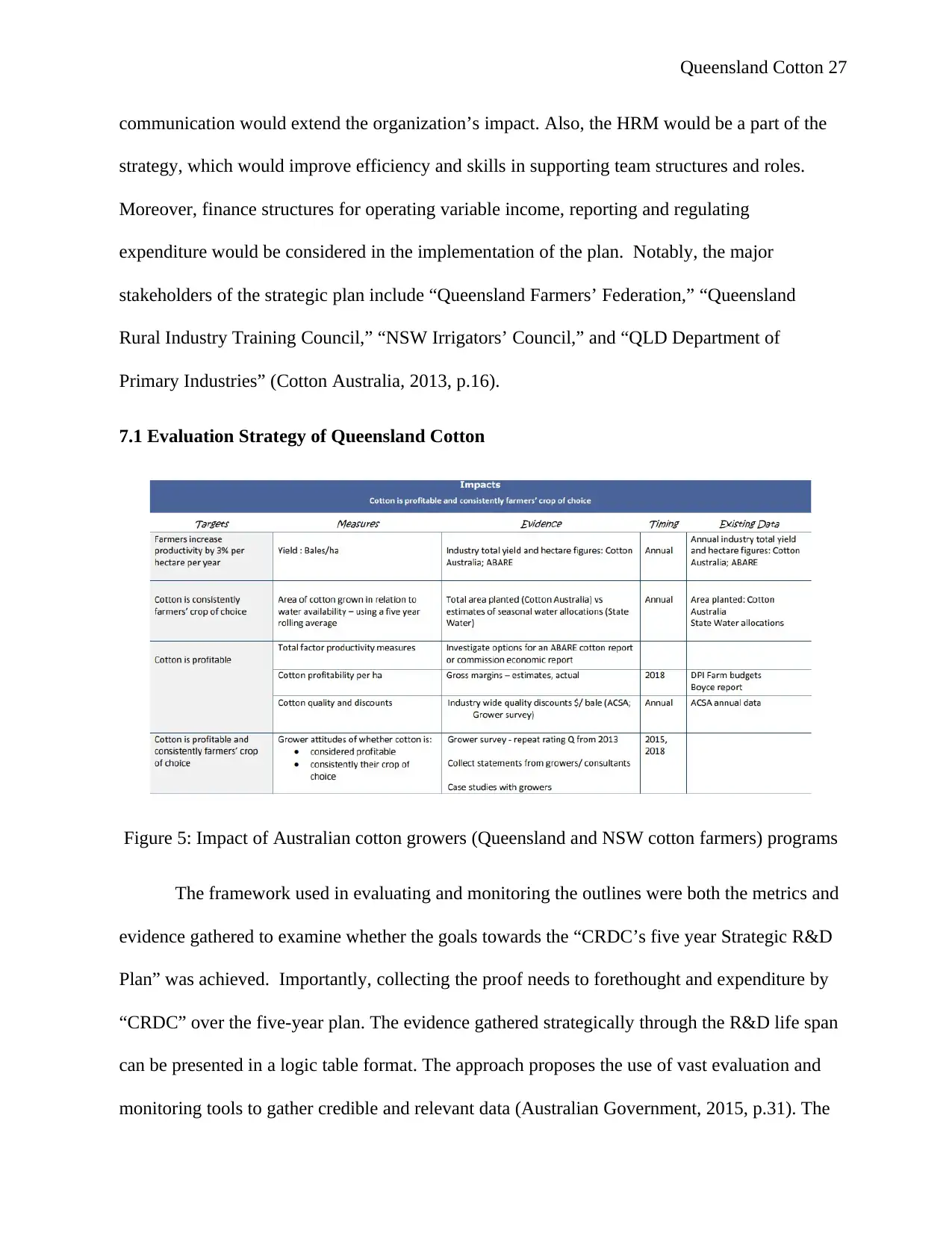
Queensland Cotton 27
communication would extend the organization’s impact. Also, the HRM would be a part of the
strategy, which would improve efficiency and skills in supporting team structures and roles.
Moreover, finance structures for operating variable income, reporting and regulating
expenditure would be considered in the implementation of the plan. Notably, the major
stakeholders of the strategic plan include “Queensland Farmers’ Federation,” “Queensland
Rural Industry Training Council,” “NSW Irrigators’ Council,” and “QLD Department of
Primary Industries” (Cotton Australia, 2013, p.16).
7.1 Evaluation Strategy of Queensland Cotton
Figure 5: Impact of Australian cotton growers (Queensland and NSW cotton farmers) programs
The framework used in evaluating and monitoring the outlines were both the metrics and
evidence gathered to examine whether the goals towards the “CRDC’s five year Strategic R&D
Plan” was achieved. Importantly, collecting the proof needs to forethought and expenditure by
“CRDC” over the five-year plan. The evidence gathered strategically through the R&D life span
can be presented in a logic table format. The approach proposes the use of vast evaluation and
monitoring tools to gather credible and relevant data (Australian Government, 2015, p.31). The
communication would extend the organization’s impact. Also, the HRM would be a part of the
strategy, which would improve efficiency and skills in supporting team structures and roles.
Moreover, finance structures for operating variable income, reporting and regulating
expenditure would be considered in the implementation of the plan. Notably, the major
stakeholders of the strategic plan include “Queensland Farmers’ Federation,” “Queensland
Rural Industry Training Council,” “NSW Irrigators’ Council,” and “QLD Department of
Primary Industries” (Cotton Australia, 2013, p.16).
7.1 Evaluation Strategy of Queensland Cotton
Figure 5: Impact of Australian cotton growers (Queensland and NSW cotton farmers) programs
The framework used in evaluating and monitoring the outlines were both the metrics and
evidence gathered to examine whether the goals towards the “CRDC’s five year Strategic R&D
Plan” was achieved. Importantly, collecting the proof needs to forethought and expenditure by
“CRDC” over the five-year plan. The evidence gathered strategically through the R&D life span
can be presented in a logic table format. The approach proposes the use of vast evaluation and
monitoring tools to gather credible and relevant data (Australian Government, 2015, p.31). The
You're viewing a preview
Unlock full access by subscribing today!
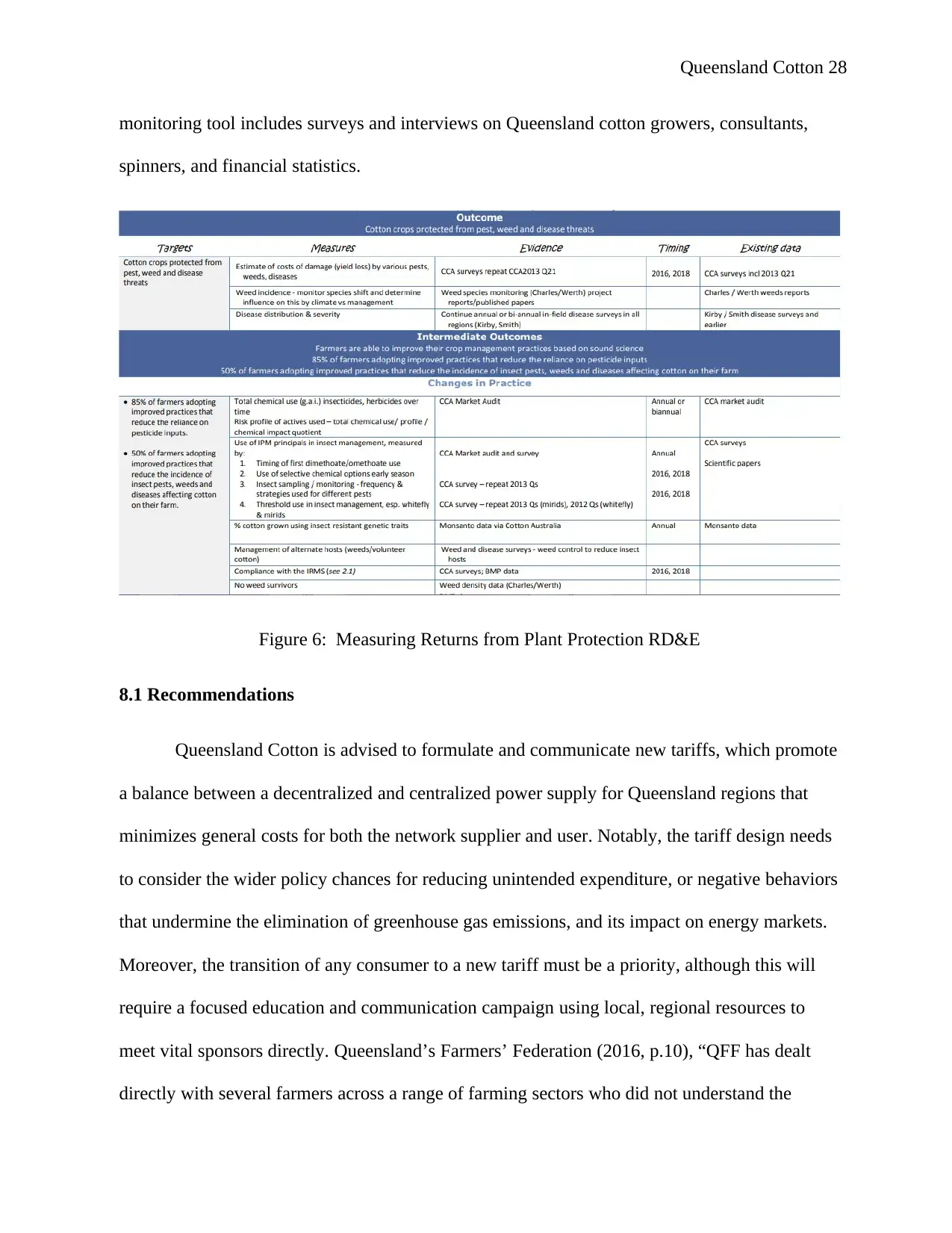
Queensland Cotton 28
monitoring tool includes surveys and interviews on Queensland cotton growers, consultants,
spinners, and financial statistics.
Figure 6: Measuring Returns from Plant Protection RD&E
8.1 Recommendations
Queensland Cotton is advised to formulate and communicate new tariffs, which promote
a balance between a decentralized and centralized power supply for Queensland regions that
minimizes general costs for both the network supplier and user. Notably, the tariff design needs
to consider the wider policy chances for reducing unintended expenditure, or negative behaviors
that undermine the elimination of greenhouse gas emissions, and its impact on energy markets.
Moreover, the transition of any consumer to a new tariff must be a priority, although this will
require a focused education and communication campaign using local, regional resources to
meet vital sponsors directly. Queensland’s Farmers’ Federation (2016, p.10), “QFF has dealt
directly with several farmers across a range of farming sectors who did not understand the
monitoring tool includes surveys and interviews on Queensland cotton growers, consultants,
spinners, and financial statistics.
Figure 6: Measuring Returns from Plant Protection RD&E
8.1 Recommendations
Queensland Cotton is advised to formulate and communicate new tariffs, which promote
a balance between a decentralized and centralized power supply for Queensland regions that
minimizes general costs for both the network supplier and user. Notably, the tariff design needs
to consider the wider policy chances for reducing unintended expenditure, or negative behaviors
that undermine the elimination of greenhouse gas emissions, and its impact on energy markets.
Moreover, the transition of any consumer to a new tariff must be a priority, although this will
require a focused education and communication campaign using local, regional resources to
meet vital sponsors directly. Queensland’s Farmers’ Federation (2016, p.10), “QFF has dealt
directly with several farmers across a range of farming sectors who did not understand the
Paraphrase This Document
Need a fresh take? Get an instant paraphrase of this document with our AI Paraphraser
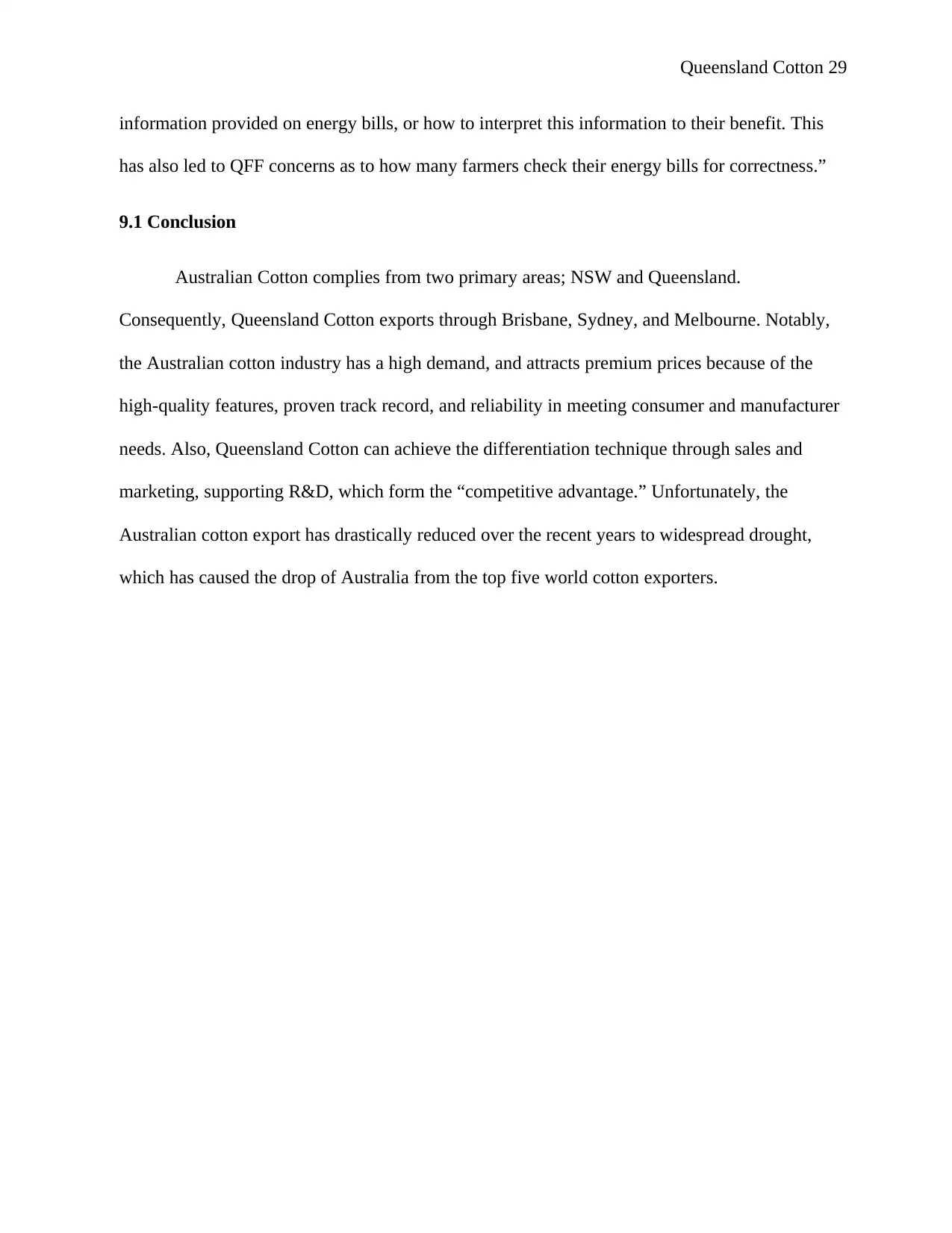
Queensland Cotton 29
information provided on energy bills, or how to interpret this information to their benefit. This
has also led to QFF concerns as to how many farmers check their energy bills for correctness.”
9.1 Conclusion
Australian Cotton complies from two primary areas; NSW and Queensland.
Consequently, Queensland Cotton exports through Brisbane, Sydney, and Melbourne. Notably,
the Australian cotton industry has a high demand, and attracts premium prices because of the
high-quality features, proven track record, and reliability in meeting consumer and manufacturer
needs. Also, Queensland Cotton can achieve the differentiation technique through sales and
marketing, supporting R&D, which form the “competitive advantage.” Unfortunately, the
Australian cotton export has drastically reduced over the recent years to widespread drought,
which has caused the drop of Australia from the top five world cotton exporters.
information provided on energy bills, or how to interpret this information to their benefit. This
has also led to QFF concerns as to how many farmers check their energy bills for correctness.”
9.1 Conclusion
Australian Cotton complies from two primary areas; NSW and Queensland.
Consequently, Queensland Cotton exports through Brisbane, Sydney, and Melbourne. Notably,
the Australian cotton industry has a high demand, and attracts premium prices because of the
high-quality features, proven track record, and reliability in meeting consumer and manufacturer
needs. Also, Queensland Cotton can achieve the differentiation technique through sales and
marketing, supporting R&D, which form the “competitive advantage.” Unfortunately, the
Australian cotton export has drastically reduced over the recent years to widespread drought,
which has caused the drop of Australia from the top five world cotton exporters.
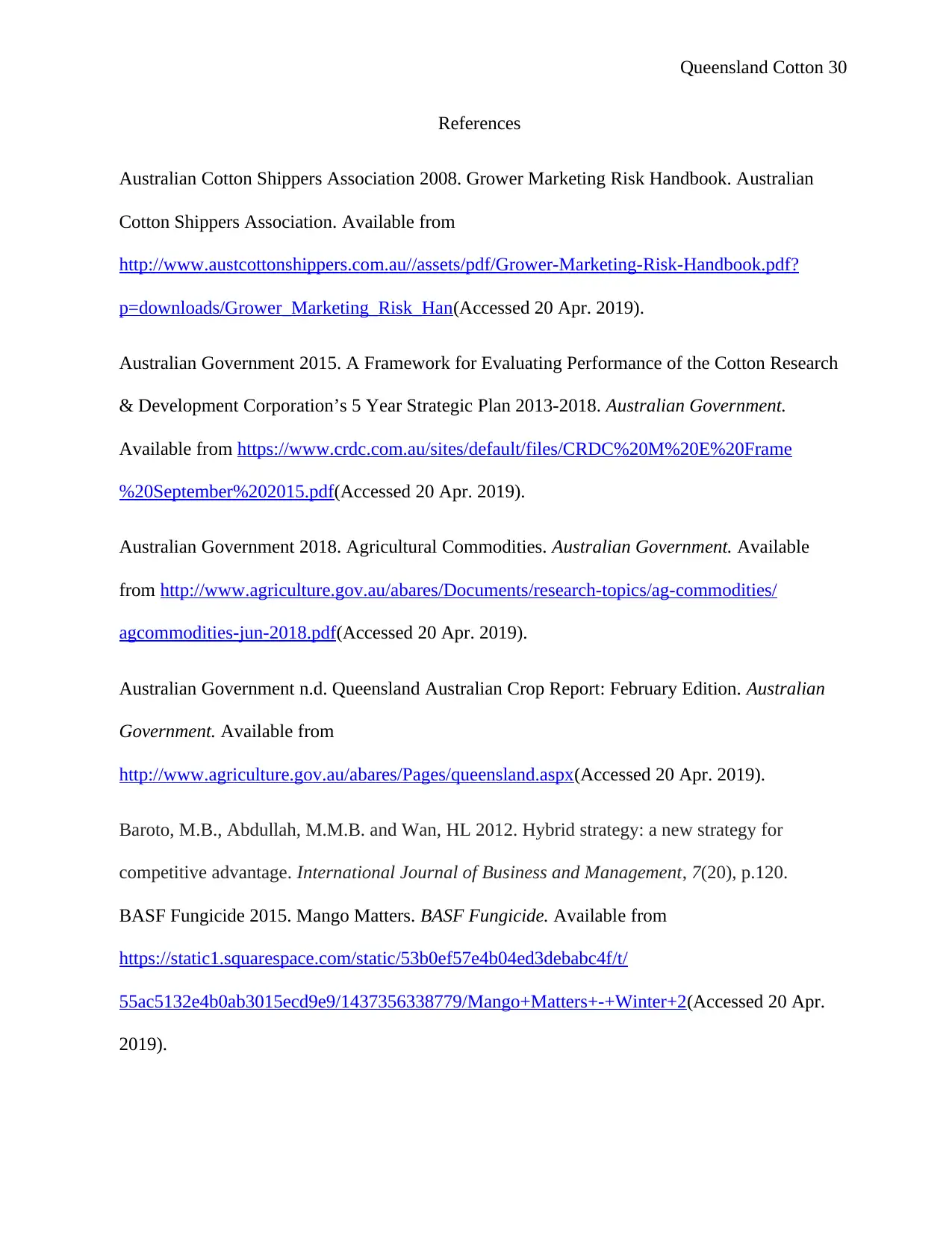
Queensland Cotton 30
References
Australian Cotton Shippers Association 2008. Grower Marketing Risk Handbook. Australian
Cotton Shippers Association. Available from
http://www.austcottonshippers.com.au//assets/pdf/Grower-Marketing-Risk-Handbook.pdf?
p=downloads/Grower_Marketing_Risk_Han(Accessed 20 Apr. 2019).
Australian Government 2015. A Framework for Evaluating Performance of the Cotton Research
& Development Corporation’s 5 Year Strategic Plan 2013-2018. Australian Government.
Available from https://www.crdc.com.au/sites/default/files/CRDC%20M%20E%20Frame
%20September%202015.pdf(Accessed 20 Apr. 2019).
Australian Government 2018. Agricultural Commodities. Australian Government. Available
from http://www.agriculture.gov.au/abares/Documents/research-topics/ag-commodities/
agcommodities-jun-2018.pdf(Accessed 20 Apr. 2019).
Australian Government n.d. Queensland Australian Crop Report: February Edition. Australian
Government. Available from
http://www.agriculture.gov.au/abares/Pages/queensland.aspx(Accessed 20 Apr. 2019).
Baroto, M.B., Abdullah, M.M.B. and Wan, HL 2012. Hybrid strategy: a new strategy for
competitive advantage. International Journal of Business and Management, 7(20), p.120.
BASF Fungicide 2015. Mango Matters. BASF Fungicide. Available from
https://static1.squarespace.com/static/53b0ef57e4b04ed3debabc4f/t/
55ac5132e4b0ab3015ecd9e9/1437356338779/Mango+Matters+-+Winter+2(Accessed 20 Apr.
2019).
References
Australian Cotton Shippers Association 2008. Grower Marketing Risk Handbook. Australian
Cotton Shippers Association. Available from
http://www.austcottonshippers.com.au//assets/pdf/Grower-Marketing-Risk-Handbook.pdf?
p=downloads/Grower_Marketing_Risk_Han(Accessed 20 Apr. 2019).
Australian Government 2015. A Framework for Evaluating Performance of the Cotton Research
& Development Corporation’s 5 Year Strategic Plan 2013-2018. Australian Government.
Available from https://www.crdc.com.au/sites/default/files/CRDC%20M%20E%20Frame
%20September%202015.pdf(Accessed 20 Apr. 2019).
Australian Government 2018. Agricultural Commodities. Australian Government. Available
from http://www.agriculture.gov.au/abares/Documents/research-topics/ag-commodities/
agcommodities-jun-2018.pdf(Accessed 20 Apr. 2019).
Australian Government n.d. Queensland Australian Crop Report: February Edition. Australian
Government. Available from
http://www.agriculture.gov.au/abares/Pages/queensland.aspx(Accessed 20 Apr. 2019).
Baroto, M.B., Abdullah, M.M.B. and Wan, HL 2012. Hybrid strategy: a new strategy for
competitive advantage. International Journal of Business and Management, 7(20), p.120.
BASF Fungicide 2015. Mango Matters. BASF Fungicide. Available from
https://static1.squarespace.com/static/53b0ef57e4b04ed3debabc4f/t/
55ac5132e4b0ab3015ecd9e9/1437356338779/Mango+Matters+-+Winter+2(Accessed 20 Apr.
2019).
You're viewing a preview
Unlock full access by subscribing today!
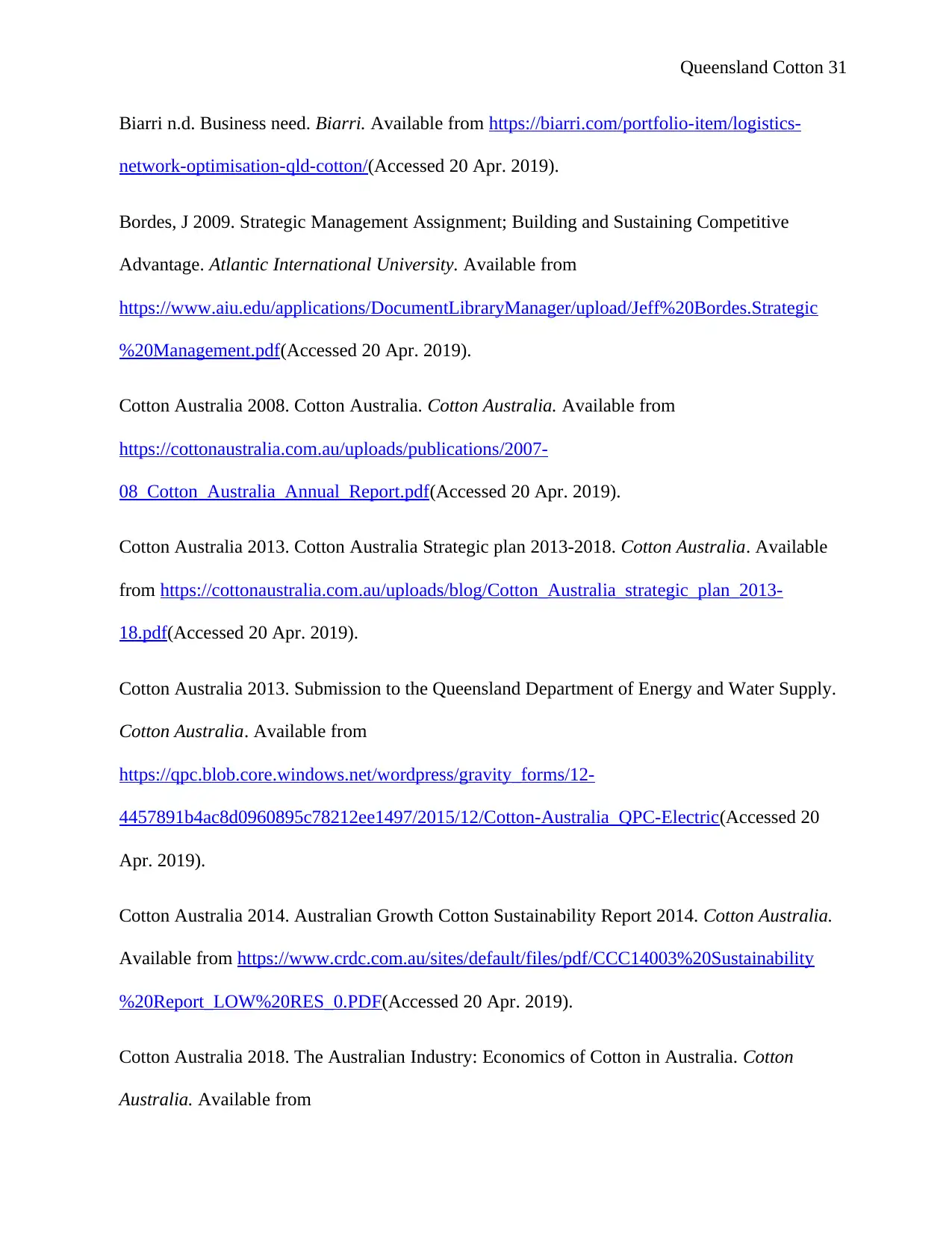
Queensland Cotton 31
Biarri n.d. Business need. Biarri. Available from https://biarri.com/portfolio-item/logistics-
network-optimisation-qld-cotton/(Accessed 20 Apr. 2019).
Bordes, J 2009. Strategic Management Assignment; Building and Sustaining Competitive
Advantage. Atlantic International University. Available from
https://www.aiu.edu/applications/DocumentLibraryManager/upload/Jeff%20Bordes.Strategic
%20Management.pdf(Accessed 20 Apr. 2019).
Cotton Australia 2008. Cotton Australia. Cotton Australia. Available from
https://cottonaustralia.com.au/uploads/publications/2007-
08_Cotton_Australia_Annual_Report.pdf(Accessed 20 Apr. 2019).
Cotton Australia 2013. Cotton Australia Strategic plan 2013-2018. Cotton Australia. Available
from https://cottonaustralia.com.au/uploads/blog/Cotton_Australia_strategic_plan_2013-
18.pdf(Accessed 20 Apr. 2019).
Cotton Australia 2013. Submission to the Queensland Department of Energy and Water Supply.
Cotton Australia. Available from
https://qpc.blob.core.windows.net/wordpress/gravity_forms/12-
4457891b4ac8d0960895c78212ee1497/2015/12/Cotton-Australia_QPC-Electric(Accessed 20
Apr. 2019).
Cotton Australia 2014. Australian Growth Cotton Sustainability Report 2014. Cotton Australia.
Available from https://www.crdc.com.au/sites/default/files/pdf/CCC14003%20Sustainability
%20Report_LOW%20RES_0.PDF(Accessed 20 Apr. 2019).
Cotton Australia 2018. The Australian Industry: Economics of Cotton in Australia. Cotton
Australia. Available from
Biarri n.d. Business need. Biarri. Available from https://biarri.com/portfolio-item/logistics-
network-optimisation-qld-cotton/(Accessed 20 Apr. 2019).
Bordes, J 2009. Strategic Management Assignment; Building and Sustaining Competitive
Advantage. Atlantic International University. Available from
https://www.aiu.edu/applications/DocumentLibraryManager/upload/Jeff%20Bordes.Strategic
%20Management.pdf(Accessed 20 Apr. 2019).
Cotton Australia 2008. Cotton Australia. Cotton Australia. Available from
https://cottonaustralia.com.au/uploads/publications/2007-
08_Cotton_Australia_Annual_Report.pdf(Accessed 20 Apr. 2019).
Cotton Australia 2013. Cotton Australia Strategic plan 2013-2018. Cotton Australia. Available
from https://cottonaustralia.com.au/uploads/blog/Cotton_Australia_strategic_plan_2013-
18.pdf(Accessed 20 Apr. 2019).
Cotton Australia 2013. Submission to the Queensland Department of Energy and Water Supply.
Cotton Australia. Available from
https://qpc.blob.core.windows.net/wordpress/gravity_forms/12-
4457891b4ac8d0960895c78212ee1497/2015/12/Cotton-Australia_QPC-Electric(Accessed 20
Apr. 2019).
Cotton Australia 2014. Australian Growth Cotton Sustainability Report 2014. Cotton Australia.
Available from https://www.crdc.com.au/sites/default/files/pdf/CCC14003%20Sustainability
%20Report_LOW%20RES_0.PDF(Accessed 20 Apr. 2019).
Cotton Australia 2018. The Australian Industry: Economics of Cotton in Australia. Cotton
Australia. Available from
Paraphrase This Document
Need a fresh take? Get an instant paraphrase of this document with our AI Paraphraser
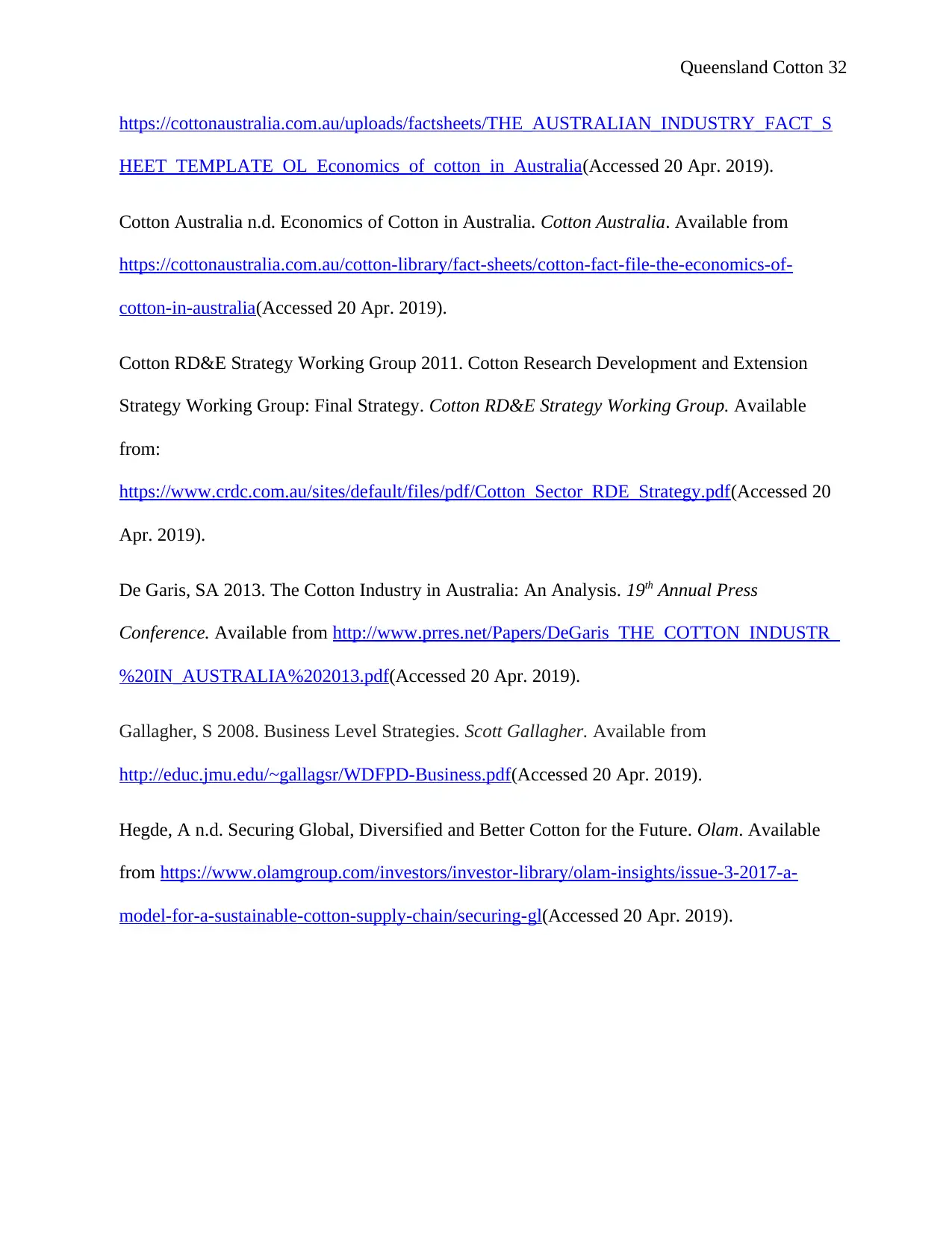
Queensland Cotton 32
https://cottonaustralia.com.au/uploads/factsheets/THE_AUSTRALIAN_INDUSTRY_FACT_S
HEET_TEMPLATE_OL_Economics_of_cotton_in_Australia(Accessed 20 Apr. 2019).
Cotton Australia n.d. Economics of Cotton in Australia. Cotton Australia. Available from
https://cottonaustralia.com.au/cotton-library/fact-sheets/cotton-fact-file-the-economics-of-
cotton-in-australia(Accessed 20 Apr. 2019).
Cotton RD&E Strategy Working Group 2011. Cotton Research Development and Extension
Strategy Working Group: Final Strategy. Cotton RD&E Strategy Working Group. Available
from:
https://www.crdc.com.au/sites/default/files/pdf/Cotton_Sector_RDE_Strategy.pdf(Accessed 20
Apr. 2019).
De Garis, SA 2013. The Cotton Industry in Australia: An Analysis. 19th Annual Press
Conference. Available from http://www.prres.net/Papers/DeGaris_THE_COTTON_INDUSTR_
%20IN_AUSTRALIA%202013.pdf(Accessed 20 Apr. 2019).
Gallagher, S 2008. Business Level Strategies. Scott Gallagher. Available from
http://educ.jmu.edu/~gallagsr/WDFPD-Business.pdf(Accessed 20 Apr. 2019).
Hegde, A n.d. Securing Global, Diversified and Better Cotton for the Future. Olam. Available
from https://www.olamgroup.com/investors/investor-library/olam-insights/issue-3-2017-a-
model-for-a-sustainable-cotton-supply-chain/securing-gl(Accessed 20 Apr. 2019).
https://cottonaustralia.com.au/uploads/factsheets/THE_AUSTRALIAN_INDUSTRY_FACT_S
HEET_TEMPLATE_OL_Economics_of_cotton_in_Australia(Accessed 20 Apr. 2019).
Cotton Australia n.d. Economics of Cotton in Australia. Cotton Australia. Available from
https://cottonaustralia.com.au/cotton-library/fact-sheets/cotton-fact-file-the-economics-of-
cotton-in-australia(Accessed 20 Apr. 2019).
Cotton RD&E Strategy Working Group 2011. Cotton Research Development and Extension
Strategy Working Group: Final Strategy. Cotton RD&E Strategy Working Group. Available
from:
https://www.crdc.com.au/sites/default/files/pdf/Cotton_Sector_RDE_Strategy.pdf(Accessed 20
Apr. 2019).
De Garis, SA 2013. The Cotton Industry in Australia: An Analysis. 19th Annual Press
Conference. Available from http://www.prres.net/Papers/DeGaris_THE_COTTON_INDUSTR_
%20IN_AUSTRALIA%202013.pdf(Accessed 20 Apr. 2019).
Gallagher, S 2008. Business Level Strategies. Scott Gallagher. Available from
http://educ.jmu.edu/~gallagsr/WDFPD-Business.pdf(Accessed 20 Apr. 2019).
Hegde, A n.d. Securing Global, Diversified and Better Cotton for the Future. Olam. Available
from https://www.olamgroup.com/investors/investor-library/olam-insights/issue-3-2017-a-
model-for-a-sustainable-cotton-supply-chain/securing-gl(Accessed 20 Apr. 2019).
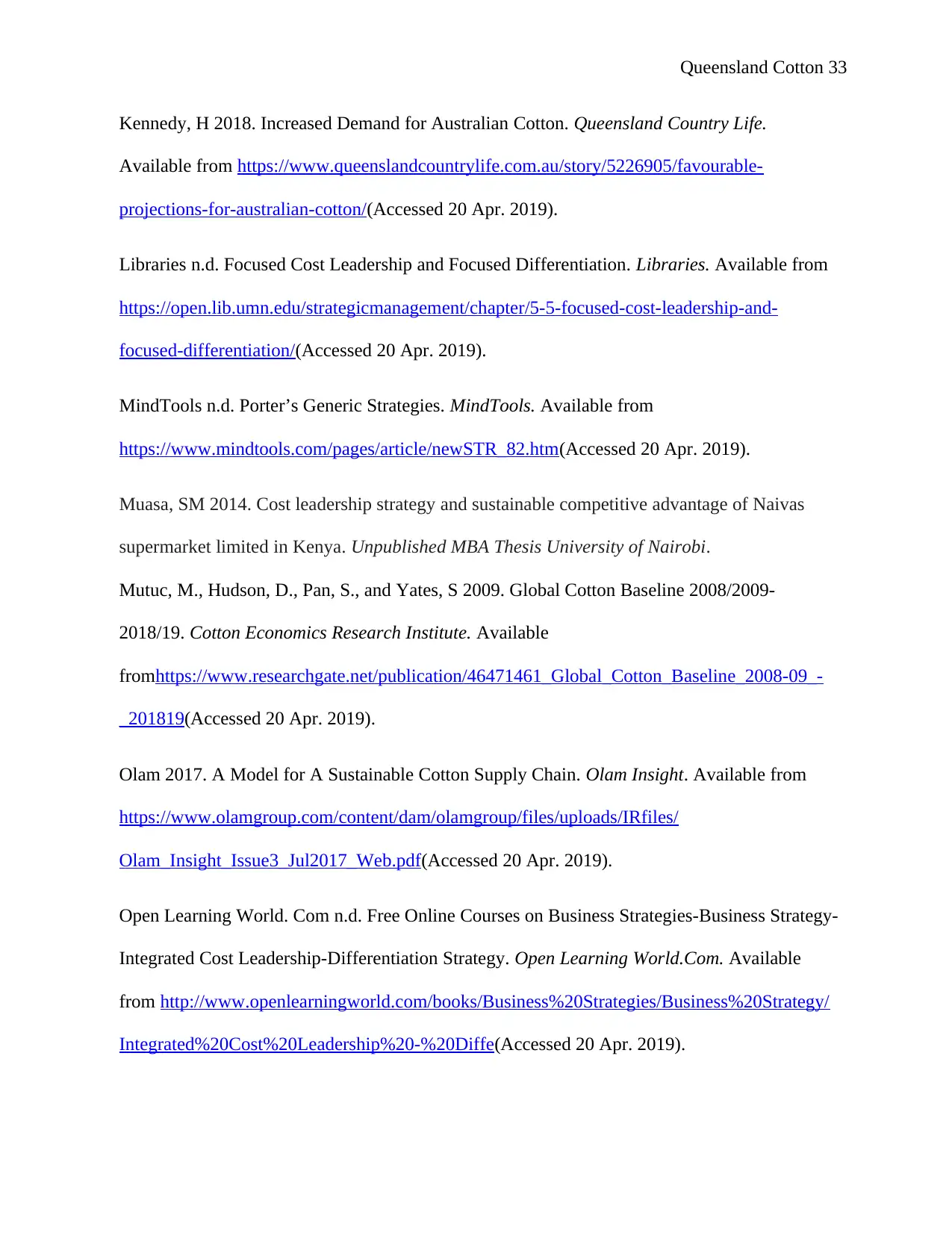
Queensland Cotton 33
Kennedy, H 2018. Increased Demand for Australian Cotton. Queensland Country Life.
Available from https://www.queenslandcountrylife.com.au/story/5226905/favourable-
projections-for-australian-cotton/(Accessed 20 Apr. 2019).
Libraries n.d. Focused Cost Leadership and Focused Differentiation. Libraries. Available from
https://open.lib.umn.edu/strategicmanagement/chapter/5-5-focused-cost-leadership-and-
focused-differentiation/(Accessed 20 Apr. 2019).
MindTools n.d. Porter’s Generic Strategies. MindTools. Available from
https://www.mindtools.com/pages/article/newSTR_82.htm(Accessed 20 Apr. 2019).
Muasa, SM 2014. Cost leadership strategy and sustainable competitive advantage of Naivas
supermarket limited in Kenya. Unpublished MBA Thesis University of Nairobi.
Mutuc, M., Hudson, D., Pan, S., and Yates, S 2009. Global Cotton Baseline 2008/2009-
2018/19. Cotton Economics Research Institute. Available
fromhttps://www.researchgate.net/publication/46471461_Global_Cotton_Baseline_2008-09_-
_201819(Accessed 20 Apr. 2019).
Olam 2017. A Model for A Sustainable Cotton Supply Chain. Olam Insight. Available from
https://www.olamgroup.com/content/dam/olamgroup/files/uploads/IRfiles/
Olam_Insight_Issue3_Jul2017_Web.pdf(Accessed 20 Apr. 2019).
Open Learning World. Com n.d. Free Online Courses on Business Strategies-Business Strategy-
Integrated Cost Leadership-Differentiation Strategy. Open Learning World.Com. Available
from http://www.openlearningworld.com/books/Business%20Strategies/Business%20Strategy/
Integrated%20Cost%20Leadership%20-%20Diffe(Accessed 20 Apr. 2019).
Kennedy, H 2018. Increased Demand for Australian Cotton. Queensland Country Life.
Available from https://www.queenslandcountrylife.com.au/story/5226905/favourable-
projections-for-australian-cotton/(Accessed 20 Apr. 2019).
Libraries n.d. Focused Cost Leadership and Focused Differentiation. Libraries. Available from
https://open.lib.umn.edu/strategicmanagement/chapter/5-5-focused-cost-leadership-and-
focused-differentiation/(Accessed 20 Apr. 2019).
MindTools n.d. Porter’s Generic Strategies. MindTools. Available from
https://www.mindtools.com/pages/article/newSTR_82.htm(Accessed 20 Apr. 2019).
Muasa, SM 2014. Cost leadership strategy and sustainable competitive advantage of Naivas
supermarket limited in Kenya. Unpublished MBA Thesis University of Nairobi.
Mutuc, M., Hudson, D., Pan, S., and Yates, S 2009. Global Cotton Baseline 2008/2009-
2018/19. Cotton Economics Research Institute. Available
fromhttps://www.researchgate.net/publication/46471461_Global_Cotton_Baseline_2008-09_-
_201819(Accessed 20 Apr. 2019).
Olam 2017. A Model for A Sustainable Cotton Supply Chain. Olam Insight. Available from
https://www.olamgroup.com/content/dam/olamgroup/files/uploads/IRfiles/
Olam_Insight_Issue3_Jul2017_Web.pdf(Accessed 20 Apr. 2019).
Open Learning World. Com n.d. Free Online Courses on Business Strategies-Business Strategy-
Integrated Cost Leadership-Differentiation Strategy. Open Learning World.Com. Available
from http://www.openlearningworld.com/books/Business%20Strategies/Business%20Strategy/
Integrated%20Cost%20Leadership%20-%20Diffe(Accessed 20 Apr. 2019).
You're viewing a preview
Unlock full access by subscribing today!
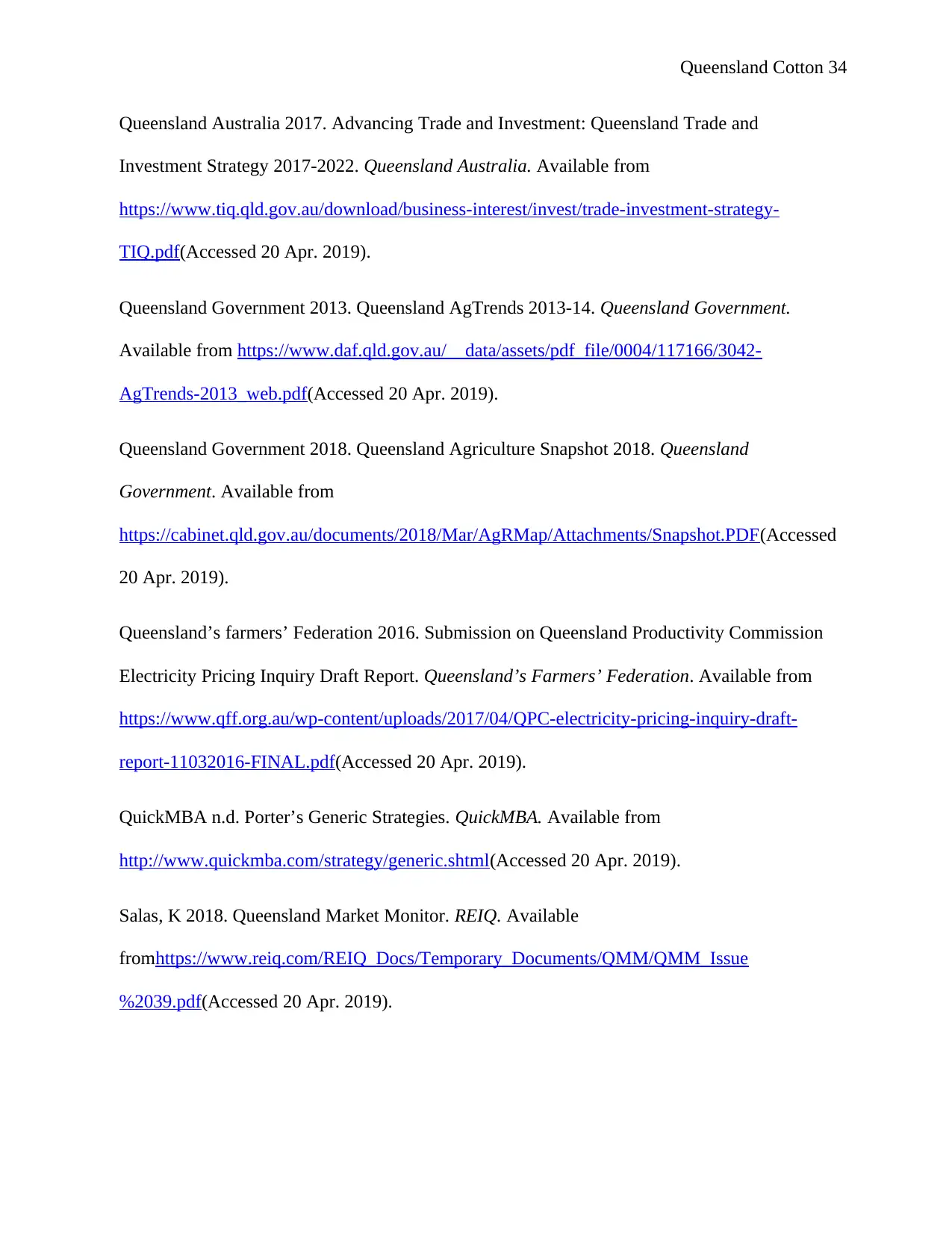
Queensland Cotton 34
Queensland Australia 2017. Advancing Trade and Investment: Queensland Trade and
Investment Strategy 2017-2022. Queensland Australia. Available from
https://www.tiq.qld.gov.au/download/business-interest/invest/trade-investment-strategy-
TIQ.pdf(Accessed 20 Apr. 2019).
Queensland Government 2013. Queensland AgTrends 2013-14. Queensland Government.
Available from https://www.daf.qld.gov.au/__data/assets/pdf_file/0004/117166/3042-
AgTrends-2013_web.pdf(Accessed 20 Apr. 2019).
Queensland Government 2018. Queensland Agriculture Snapshot 2018. Queensland
Government. Available from
https://cabinet.qld.gov.au/documents/2018/Mar/AgRMap/Attachments/Snapshot.PDF(Accessed
20 Apr. 2019).
Queensland’s farmers’ Federation 2016. Submission on Queensland Productivity Commission
Electricity Pricing Inquiry Draft Report. Queensland’s Farmers’ Federation. Available from
https://www.qff.org.au/wp-content/uploads/2017/04/QPC-electricity-pricing-inquiry-draft-
report-11032016-FINAL.pdf(Accessed 20 Apr. 2019).
QuickMBA n.d. Porter’s Generic Strategies. QuickMBA. Available from
http://www.quickmba.com/strategy/generic.shtml(Accessed 20 Apr. 2019).
Salas, K 2018. Queensland Market Monitor. REIQ. Available
fromhttps://www.reiq.com/REIQ_Docs/Temporary_Documents/QMM/QMM_Issue
%2039.pdf(Accessed 20 Apr. 2019).
Queensland Australia 2017. Advancing Trade and Investment: Queensland Trade and
Investment Strategy 2017-2022. Queensland Australia. Available from
https://www.tiq.qld.gov.au/download/business-interest/invest/trade-investment-strategy-
TIQ.pdf(Accessed 20 Apr. 2019).
Queensland Government 2013. Queensland AgTrends 2013-14. Queensland Government.
Available from https://www.daf.qld.gov.au/__data/assets/pdf_file/0004/117166/3042-
AgTrends-2013_web.pdf(Accessed 20 Apr. 2019).
Queensland Government 2018. Queensland Agriculture Snapshot 2018. Queensland
Government. Available from
https://cabinet.qld.gov.au/documents/2018/Mar/AgRMap/Attachments/Snapshot.PDF(Accessed
20 Apr. 2019).
Queensland’s farmers’ Federation 2016. Submission on Queensland Productivity Commission
Electricity Pricing Inquiry Draft Report. Queensland’s Farmers’ Federation. Available from
https://www.qff.org.au/wp-content/uploads/2017/04/QPC-electricity-pricing-inquiry-draft-
report-11032016-FINAL.pdf(Accessed 20 Apr. 2019).
QuickMBA n.d. Porter’s Generic Strategies. QuickMBA. Available from
http://www.quickmba.com/strategy/generic.shtml(Accessed 20 Apr. 2019).
Salas, K 2018. Queensland Market Monitor. REIQ. Available
fromhttps://www.reiq.com/REIQ_Docs/Temporary_Documents/QMM/QMM_Issue
%2039.pdf(Accessed 20 Apr. 2019).
Paraphrase This Document
Need a fresh take? Get an instant paraphrase of this document with our AI Paraphraser
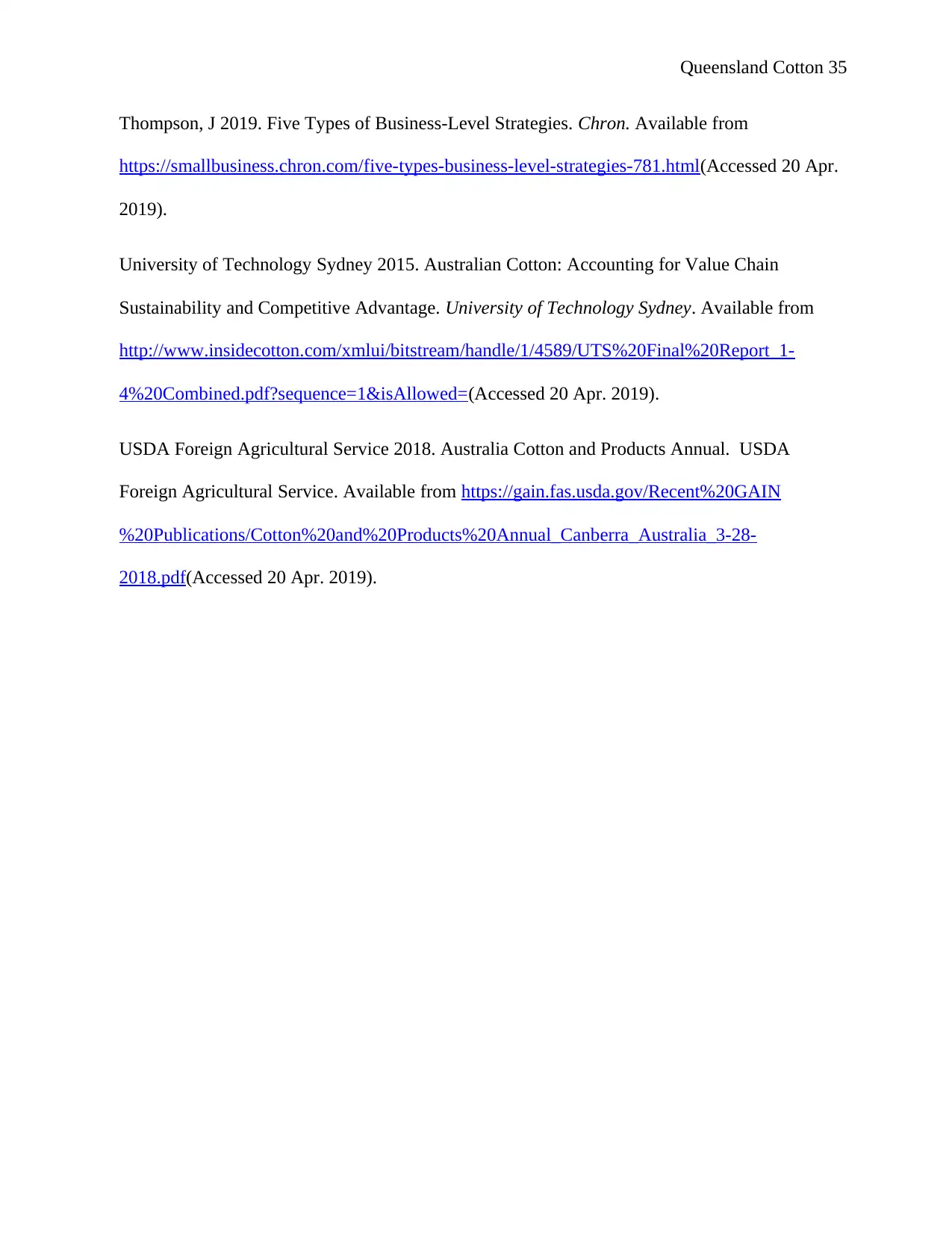
Queensland Cotton 35
Thompson, J 2019. Five Types of Business-Level Strategies. Chron. Available from
https://smallbusiness.chron.com/five-types-business-level-strategies-781.html(Accessed 20 Apr.
2019).
University of Technology Sydney 2015. Australian Cotton: Accounting for Value Chain
Sustainability and Competitive Advantage. University of Technology Sydney. Available from
http://www.insidecotton.com/xmlui/bitstream/handle/1/4589/UTS%20Final%20Report_1-
4%20Combined.pdf?sequence=1&isAllowed=(Accessed 20 Apr. 2019).
USDA Foreign Agricultural Service 2018. Australia Cotton and Products Annual. USDA
Foreign Agricultural Service. Available from https://gain.fas.usda.gov/Recent%20GAIN
%20Publications/Cotton%20and%20Products%20Annual_Canberra_Australia_3-28-
2018.pdf(Accessed 20 Apr. 2019).
Thompson, J 2019. Five Types of Business-Level Strategies. Chron. Available from
https://smallbusiness.chron.com/five-types-business-level-strategies-781.html(Accessed 20 Apr.
2019).
University of Technology Sydney 2015. Australian Cotton: Accounting for Value Chain
Sustainability and Competitive Advantage. University of Technology Sydney. Available from
http://www.insidecotton.com/xmlui/bitstream/handle/1/4589/UTS%20Final%20Report_1-
4%20Combined.pdf?sequence=1&isAllowed=(Accessed 20 Apr. 2019).
USDA Foreign Agricultural Service 2018. Australia Cotton and Products Annual. USDA
Foreign Agricultural Service. Available from https://gain.fas.usda.gov/Recent%20GAIN
%20Publications/Cotton%20and%20Products%20Annual_Canberra_Australia_3-28-
2018.pdf(Accessed 20 Apr. 2019).
1 out of 35
Related Documents
Your All-in-One AI-Powered Toolkit for Academic Success.
+13062052269
info@desklib.com
Available 24*7 on WhatsApp / Email
![[object Object]](/_next/static/media/star-bottom.7253800d.svg)
Unlock your academic potential
© 2024 | Zucol Services PVT LTD | All rights reserved.




